Forums
- Forums
- Axis And Allies Forum
- General Discussion
- Aviation News
Aviation News
Post a reply
- Go to Next topic
- Go to Welcome
- Go to Introduce Yourself
- Go to General Discussion
- Go to Screenshots, Images and Videos
- Go to Off topic
- Go to Works in Progress
- Go to Skinning Tips / Tutorials
- Go to Skin Requests
- Go to IJAAF Library
- Go to Luftwaffe Library
- Go to RAF Library
- Go to USAAF / USN Library
- Go to Misc Library
- Go to The Ops Room
- Go to Made in Germany
- Go to Campaigns and Missions
- Go to Works in Progress
- Go to Juri's Air-Raid Shelter
- Go to Campaigns and Missions
- Go to Works in Progress
- Go to Skinpacks
- Go to External Projects Discussion
- Go to Books & Resources
-
 Main AdminU.S. Air Force Maj. Brannon Ferguson, a pilot assigned to the 159th Fighter Squadron, pilots the final flight of an F-15C Eagle jet as it heads to the “boneyard” at Davis-Monthan Air Force Base in Tucson, Arizona, Aug. 14, 2023. The departure represents the wing’s divesture in the F-15C Eagle airframe as the installation prepares to receive the first batch of F-35 Lightning II aircraft in early 2025. Conversion training for Airmen and infrastructure changes are currently underway to prepare for the change in mission, which will equip the wing with the Air Force’s most sophisticated fifth-generation fighter. The arrival of F-35s will posture 125th FW Airmen to meet air superiority and global strike needs for our nation’s defense, and mark the end of a 30-year era flying F-15 fighter jets. (U.S. Air Force photo by Tech Sgt. Chelsea Smith)
Main AdminU.S. Air Force Maj. Brannon Ferguson, a pilot assigned to the 159th Fighter Squadron, pilots the final flight of an F-15C Eagle jet as it heads to the “boneyard” at Davis-Monthan Air Force Base in Tucson, Arizona, Aug. 14, 2023. The departure represents the wing’s divesture in the F-15C Eagle airframe as the installation prepares to receive the first batch of F-35 Lightning II aircraft in early 2025. Conversion training for Airmen and infrastructure changes are currently underway to prepare for the change in mission, which will equip the wing with the Air Force’s most sophisticated fifth-generation fighter. The arrival of F-35s will posture 125th FW Airmen to meet air superiority and global strike needs for our nation’s defense, and mark the end of a 30-year era flying F-15 fighter jets. (U.S. Air Force photo by Tech Sgt. Chelsea Smith)
An F/A-18F Super Hornet, attached to the “Blacklions” of Strike Fighter Squadron (VFA) 213, launches from the flight deck of the world’s largest aircraft carrier USS Gerald R. Ford (CVN 78), Aug. 14, 2023. Gerald R. Ford is the U.S. Navy's newest and most advanced aircraft carrier, representing a generational leap in the U.S. Navy's capacity to project power on a global scale. The Gerald R. Ford Carrier Strike Group is on a scheduled deployment in the U.S. Naval Forces Europe area of operations, employed by U.S. Sixth Fleet to defend U.S., allied, and partner interests. (U.S. Navy photo by Mass Communication Specialist 3rd Class Simon Pike)_Aug._14_2023.jpg?width=1920&height=1080&fit=bounds)
U.S. Air Force F-35A Lightning II with the 58th Fighter Squadron, 33rd Fighter Wing, Eglin Air Force Base, Florida, prepares to launch at Volk Field Air National Guard Base, Wisconsin, Aug. 9, 2023. Northern Lightning gives multiple generations of aircraft the opportunity to integrate and train together. (U.S. Air Force photo by Airman 1st Class Abigail Duell)
Airmen assigned to 87th Electronic Warfare Squadron Combat Shield assess the defensive system readiness of a U.S Air Force F-16 Fighting Falcon at Misawa Air Base, Japan, Aug. 9, 2023. Combat Shield is the lead U.S. Air Force air electronic warfare (EW) assessment program and is responsible for advising all MAJCOM-specific EW assessment programs. (U.S. Air Force photo by Staff Sgt. Ericka A. Woolever)
QinetiQ’s Airborne Technology Demonstrator (ATD) in partnership with BAE Systems, underpinned by the Long Term Partnering Agreement with the MOD, has conducted a flight test with the combat aircraft nose system (fast jet radome) installed onto the RJ100, paving the way to future radar and sensor integration capability. This will enable the ATD to support a breadth of future programmes, as the aircraft expands its offering as the most capable flying testbed available in the UK today to support a variety of technology developments in the sector, and will now become a core T3E capability offering under the LTPA.
The flight also represents the first major Ministry of Defence (MOD) trial conducted under Category 1 Flight Test and is the first trial of its kind in the UK for 30 years. The addition of the radome is an exciting development in UK flight test capability and builds on QinetiQ’s Aviation Engineering Centre (AEC) exceptional track-record in aircraft design and modification, a key T3E offering under the LTPA.
Using an RJ100 airframe, the addition of the radome is just the latest in a series of modifications to this platform. Transformed into a flying laboratory and classroom, the ATD provides power and data backbones and multiple flexible workstations to enable research and development projects to be quickly and easily integrated.
A bespoke, modular multi-role capability that meets the requirements of both military and civil customers, the ATD supports cost-effective specialist training, experimentation, air carriage, and test and evaluation (T&E) activities. The aircraft is purpose built to simplify the route of getting technology under development into airborne environment.
Nic Anderson, Chief Executive UK Defence, QinetiQ: "Building on QinetiQ’s Aviation Engineering Centre’s exceptional track record in aircraft design and modification, the ATD represents an exciting development in UK flight test capability. Working with BAE Systems in collaboration to support the development of future sensors and technology is a great demonstration of our expertise in aviation engineering, airworthiness and test and evaluation."
Steve Wynd, Engineering Director – Air Sector, BAE Systems: "Using a flying test bed in this way allows us to much more rapidly test, develop and prove new digital technologies, with particular focus on Model Based Systems Engineering. We’re really excited in the potential this provides and look forward to our continued collaboration with QinetiQ."
Merlins from Culdrose are to make a Norwegian anti-submarine exercise an annual fixture after their debut at Green Eel in June.
Around 100 personnel deployed to western Norway to pit their skills against German and Norwegian boats in the fjords around Bergen.
Participation in the exercise follows an Anglo-Norwegian agreement to work more closely to protect critical undersea infrastructure.
(Photos courtesy of the RN)
-
 Main AdminA U.S. Navy EA-18G Growler assigned to the Electronic Attack Squadron 134 takes off during Red Flag-Alaska 23-3 at Eielson Air Force Base, Alaska, Aug. 14, 2023. Integrating the U.S. Air Force and Navy strengthens joint planning, communication and execution to enhance interoperability and joint operational effectiveness. (U.S. Air Force photo by Senior Airman Megan Estrada)
Main AdminA U.S. Navy EA-18G Growler assigned to the Electronic Attack Squadron 134 takes off during Red Flag-Alaska 23-3 at Eielson Air Force Base, Alaska, Aug. 14, 2023. Integrating the U.S. Air Force and Navy strengthens joint planning, communication and execution to enhance interoperability and joint operational effectiveness. (U.S. Air Force photo by Senior Airman Megan Estrada)
An F-16 Fighting Falcon assigned to the 18th Aggressor Squadron takes off for a mission during Red Flag-Alaska 23-3 at Eielson Air Force Base, Alaska, Aug. 14, 2023. The Aggressors will provide participants a realistic opposing force by employing enemy tactics during air combat training. (U.S. Air Force photo by Senior Airman Megan Estrada)
A U.S. Marine Corps F-35B Lightning II assigned to Fighter Attack Squadron 121 takes flight during Red Flag-Alaska 23-3 at Eielson Air Force Base, Alaska, Aug. 14, 2023. Red Flag provides unique opportunities to integrate various forces into joint coalition and multilateral training from simulated forward operating bases. (U.S. Air Force photo by Senior Airman Megan Estrada)
GULF OF OMAN (Aug. 13, 2023) A U.S. Marine Corps AV-8B Harrier II aircraft, attached to Marine Medium Tiltrotor Squadron 162, 26th Marine Expeditionary Unit (MEU), prepares for takeoff during flight operations aboard amphibious assault ship USS Bataan (LHD 5) in the Gulf of Oman, Aug. 13, 2023. Components of the Bataan Amphibious Ready Group and 26th MEU are deployed to the U.S. 5th Fleet area of operations to help ensure maritime security and stability in the Middle East region. (U.S. Marine Corps photo by Sgt. Matthew Romonoyske-Bean)_prepares_for_takeoff_during_flight_operations_aboard_amphibious_assault_ship_USS_Bataan.jpg?width=1920&height=1080&fit=bounds)
GULF OF OMAN (Aug. 14, 2023) A Sailor assigned to amphibious assault ship USS Bataan (LHD 5) directs a U.S. Marine Corps AV-8B Harrier II aircraft, attached to Marine Medium Tiltrotor Squadron 162, 26th Marine Expeditionary Unit (MEU), in the Gulf of Oman, Aug. 14, 2023. Components of the Bataan Amphibious Ready Group and 26th MEU are deployed to the U.S. 5th Fleet area of operations to help ensure maritime security and stability in the Middle East region. (U.S. Marine Corps photo by Sgt. Matthew Romonoyske-Bean)_in_the_Gulf_of_Oman_Aug._14_2023.jpg?width=1920&height=1080&fit=bounds)
A KC-130J Hercules assigned to Marine Aerial Refueler Transport Squadron 153 (VMGR-153), Marine Aircraft Group 24, 1st Marine Air Wing, departs from Marine Corps Air Station Kaneohe Bay, Marine Corps Base Hawaii, August 14, 2023. At the request of U.S. Army Pacific, and in accordance with U.S. federal law, Hawaii based U.S. Marines with VMGR-153 provided transportation to Joint Task Force 50 personnel and equipment from Oahu to Maui. Joint Task Force 50 is the command and control element which will coordinate DoD response efforts upon request from appropriate government authorities. (U.S. Marine Corps photo by Lance Cpl. Logan Beeney)_Marine_Aircraft_Group_24_1st_Marine_Air_Wing_departs_from_Marine_Corps_Air_Station_Kaneohe_Bay.jpg?width=1920&height=1080&fit=bounds)
An F-16 "Fighting Falcon" assigned to the 125th Expeditionary Fighter Squadron sits on the flight-line after hot pit refueling at Prince Sultan Air Base, Kingdom of Saudi Arabia, Aug. 15, 2023. Hot pit refueling occurs after an aircraft has landed and is still running its engine. The technique allows refueling in austere locations and illustrates Agile Combat Employment (ACE) capabilities. (U.S. Air Force photo by Tech. Sgt. Alexander Frank)
A U.S. Air Force F-16 Fighting Falcon assigned to the 555th Expeditionary Fighter Squadron, prepares for take-off at King Faisal Air Base in Tabuk, Saudi Arabia, Aug. 15, 2023, during Operation Agile Spartan 23.2. Operation Agile Spartan is an exercise designed to increase interoperability around partners and allies in the region while advancing agile combat employment capabilities across U.S. Central Command’s area of responsibility. (U.S. Air Force photo by Staff Sgt. Christopher Sommers)
-
 Main AdminARLINGTON, Va. (AFNS) --
Main AdminARLINGTON, Va. (AFNS) --
The Department of the Air Force selected JetZero for the next phase of a blended wing body prototype aircraft project Aug. 16.
Shown is a rendering of the blended wing body prototype aircraft. On Aug. 16, 2023, the Department of the Air Force selected JetZero for the BWB prototype aircraft project. The effort aims to mature BWB technology and demonstrate its capabilities, giving the department and commercial industry more options for future air platforms. (U.S. Air Force graphic)
The effort aims to mature BWB technology and demonstrate its capabilities, giving the department and commercial industry more options for future air platforms.
With a design that differs from a traditional tube-and-wing aircraft, the BWB blends the aircraft body into its high-aspect-ratio wing, decreasing aerodynamic drag by at least 30% and providing additional lift. This increased efficiency will enable extended range, more loiter time, and increased payload delivery efficiencies, capabilities that are vital to mitigating logistics risks.
“Blended wing body aircraft have the potential to significantly reduce fuel demand and increase global reach,” said Secretary of the Air Force Frank Kendall. “Moving forces and cargo quickly, efficiently, and over long distance is a critical capability to enable national security strategy.”
Several military transport configurations are possible with the BWB. Together, these aircraft types account for approximately 60% of the Air Force’s total annual jet fuel consumption.
As outlined in the fiscal year 2023 National Defense Authorization Act, the Department of Defense plans to invest $235 million over the next four years to fast-track the development of this transformational dual-use technology, with additional private investment expected. The effort is the result of collaboration between the Department of the Air Force, the National Aeronautics and Space Administration, and the Defense Innovation Unit, with assistance from the DoD’s Office of Strategic Capital.
“It’s been a little over a hundred years since a few brave Airmen took to the skies and proved the first aerial refueling capability, extending the global reach of our Air Force. This announcement marks another game-changing milestone for the Air Force in our efforts to maintain the advantage of airpower effectiveness against any future competitors,” said Dr. Ravi Chaudhary, assistant secretary of the Air Force for Energy, Installations, and Environment. A former C-17 Globemaster III pilot and engineer, Chaudhary is leading efforts to ensure efficiencies in operational energy to build greater agility for theater commanders.
While the BWB concept has been around for decades, more recent technology advancements in structural design, materials technology, manufacturing, and other areas have made large-scale production achievable.
The commercial industry, including passenger airlines and air freight companies, stand to benefit from development of this technology as well, increasing available cabin or cargo space while decreasing operational fuel costs.
The Air Force Operational Energy Office expects completion of initial flight testing as early as 2027.
Shown is a rendering of the blended wing body prototype aircraft. On Aug. 16, 2023, the Department of the Air Force selected JetZero for the BWB prototype aircraft project. The effort aims to mature BWB technology and demonstrate its capabilities, giving the department and commercial industry more options for future air platforms. (U.S. Air Force graphic)
A U.S. Air Force F-16 Fighting Falcon, assigned to the 18th Aggressor Squadron, Eielson Air Force Base, awaits refueling from a KC-135 Stratotanker assigned to the 168th Air Refueling Squadron over the Joint Pacific-Alaska Range Complex during Red Flag-Alaska 23-3, Aug. 15, 2023. The 18th Aggressor Squadron supports Red Flag- Alaska by sharing its knowledge of adversarial tactics, techniques, and procedures to participating units. This ensures the United States and its allies receive the best air-combat training possible.
(U.S. Air Force photo by Airman 1st Class Quatasia Carter)
A U.S. Air F-22 Raptor assigned to the 3rd Wing at Joint Base Elmendorf-Richardson detaches from the refueling boom of a KC-135 Stratotanker assigned to the 168th Air Refueling Squadron over the Joint Pacific-Alaska Range Complex during Red Flag-Alaska 23-3, Aug. 15, 2023. This exercise provides unique opportunities to integrate various forces into joint, coalition and multilateral training from simulated forward operating bases. (U.S. Air Force photo by Airman 1st Class Quatasia Carter)
Two 393rd Expeditionary Bomb Squadron pilots approach a B-2 Spirit during Bomber Task Force 24-4, Keflavik, Iceland, Aug. 15, 2023. BTF operations are U.S. Strategic Command's means of conducting Dynamic Force Employment in support of the Department of Defense's National Defense Strategy at the direction of the President of the United States. (U.S. Air Force photo by Tech. Sgt. Heather Salazar)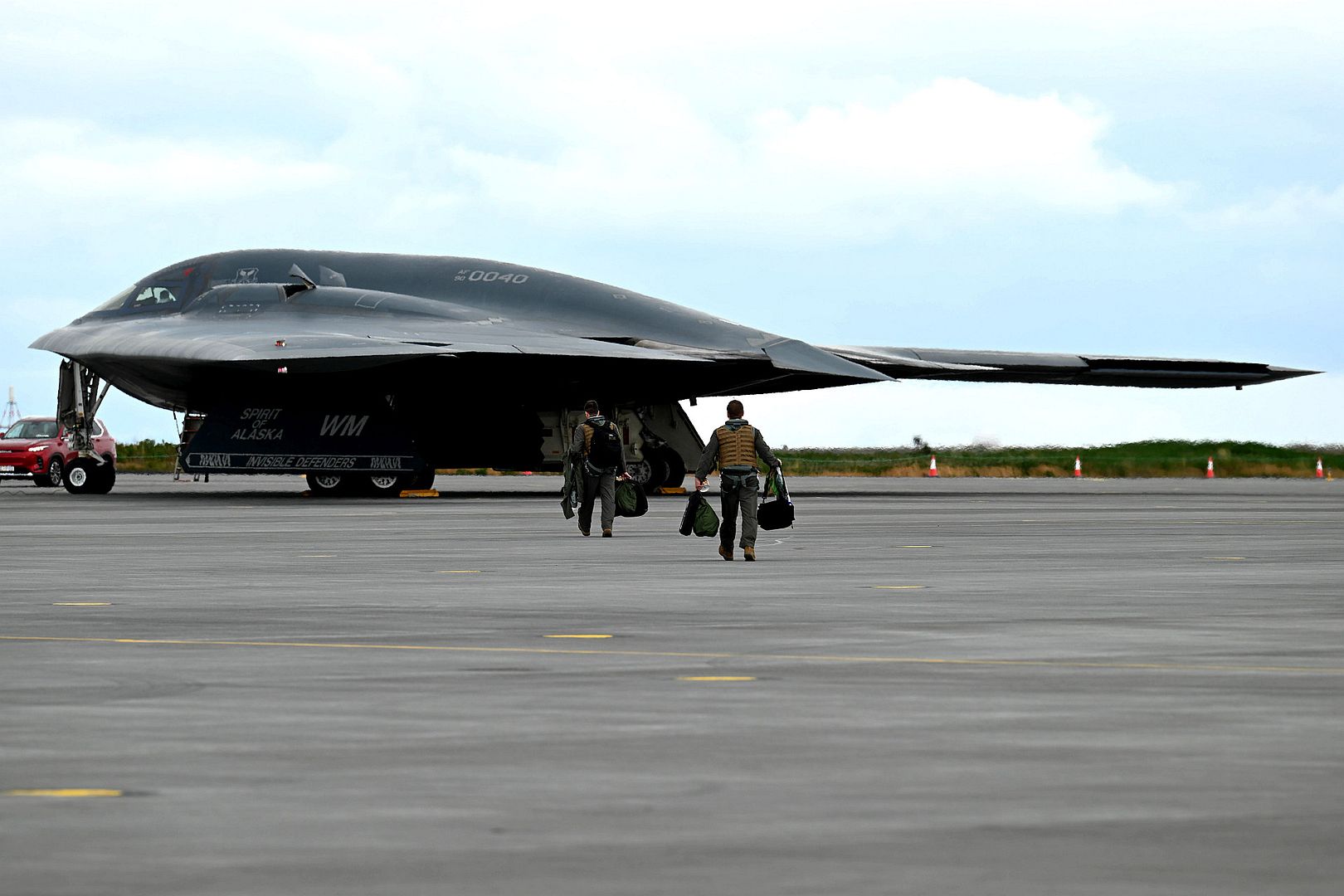
MARCH AIR RESERVE BASE, Calif. — A KC-10A aircraft, tail number KC-10A 84-0185, which began its service at March Air Reserve Base and later transferred to Travis, has returned to undergo a significant demilitarization process. This storied aircraft will soon be showcased as an exhibit at the nearby March Field Air Museum, marking a full circle in its journey.
(Photos by Wendy Day)
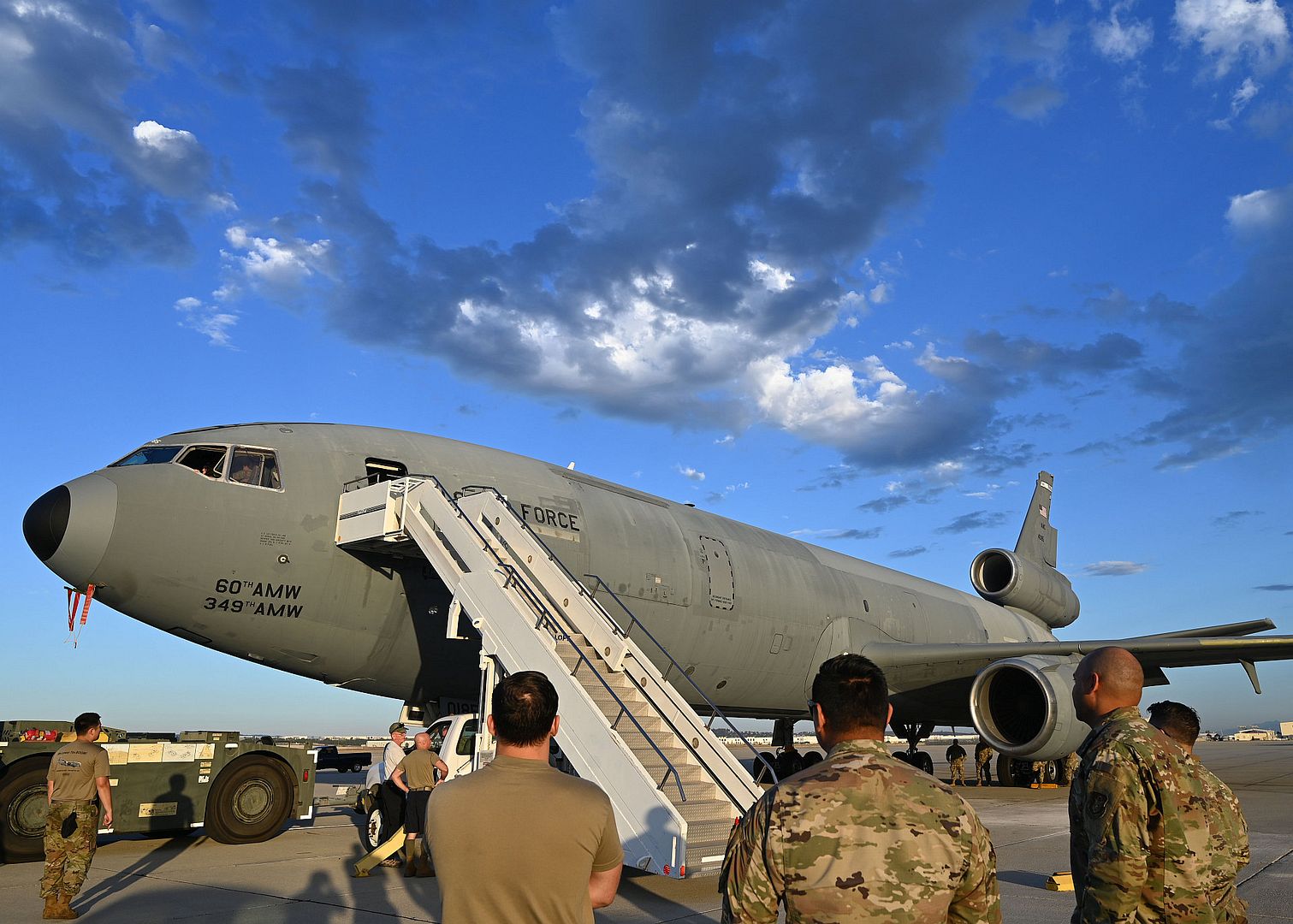
An A-10C "Warthog" Thunderbolt II from the 175th Fighter Wing flies alongside a KC-135 Stratotanker with the 121st Air Refueling Wing after being refueled over the skies of Virginia, August 16, 2023. The KC-135 is a unique asset that provides aerial refueling to enhance global mobility, enabling other aircraft to defend the homeland and deter the use of nuclear weapons. (U.S. Air National Guard photo by Airman First Class Ivy Thomas)
This HH-60G Pave Hawk, s/n 92-26463 lead an April 2004 mission to rescue five U.S. Army soldiers whose helicopter crashed during a sandstorm near Kharbut, Iraq. The crew of this aircraft was awarded the Mackay Trophy for most meritorious flight of the year by a U.S. Air Force crew. The helicopter was flown to the National Museum of the U.S. Air Force on 16 August, 2023, by a crew from the 66th Expeditionary Rescue Squadron, Nellis Air Force Base. The helicopter will become a permanent part of the museum's collection. (U.S. Air Force photo by Ty Greenlees)
F-16 Fighting Falcons from the 148th Fighter Wing, Minnesota Air National Guard, and 180th Fighter Wing, Ohio Air National Guard, are lined up at at Volk Field Combat Readiness Training Center, Wisconsin, August 15, 2023 in support of Northern Lightning. Northern Lightning, featuring nearly 60 aircraft and 1,000 personnel, is a joint training exercise, emphasizing user-defined objectives resulting in tailored, scenario-based, full spectrum, high-end training. (U.S. Air National Guard photos by Audra Flanagan)
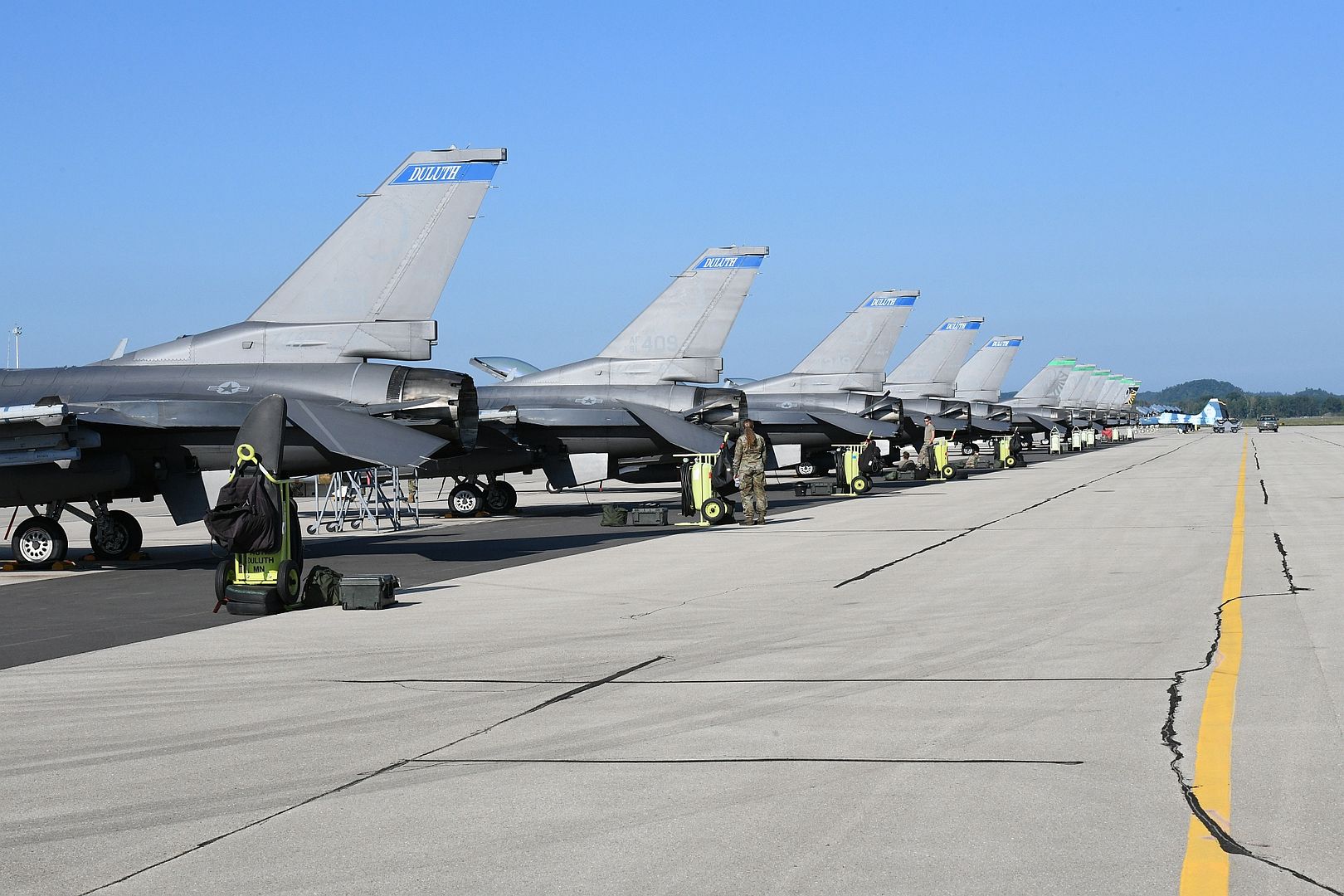
PALMDALE, Calif., Aug. 17, 2023 /PRNewswire/ -- Boeing [NYSE:BA] has ferried an MD-90 airplane to the site where it will be modified to test the Transonic Truss-Braced Wing (TTBW) configuration as part of NASA's Sustainable Flight Demonstrator project.
As Boeing, NASA and community leaders gathered at the company's facility today to recognize the milestone in development of the experimental X-66A aircraft, Boeing released photos of the jet's journey from Victorville, Calif., to Palmdale.
The X-66A is NASA's first experimental plane focused on helping the U.S. achieve its goal of net-zero aviation greenhouse gas emissions. Modification will begin soon and ground and flight testing is expected to begin in 2028.
"This marks an important step in the Sustainable Flight Demonstrator project, advances Boeing's commitment to sustainability and brings us closer to testing and validating the TTBW design," said Boeing Chief Technology Officer Todd Citron.
With ultrathin wings braced by struts with larger spans and higher-aspect ratios, the TTBW design and other expected technological advances could lead to reductions in fuel use and emissions by up to 30%. Boeing and NASA have collaborated for more than a decade on the concept through the Subsonic Ultra Green Aircraft Research (SUGAR) Program.
"We at NASA are excited to be working with Boeing on the X-66A Sustainable Flight Demonstrator making critical contributions to accelerate aviation towards its 2050 net-zero greenhouse gas emission goal," said Ed Waggoner, deputy associate administrator for programs in the NASA Aeronautics Research Mission Directorate.
"Aerospace Valley has a long and distinguished history as the cradle of aerospace innovation, and this unveiling is a continuation of that critical work. Palmdale's talented workforce and infrastructure make it the perfect location for this important project," said Congressman Mike Garcia (CA-27).
As a leading global aerospace company, Boeing develops, manufactures and services commercial airplanes, defense products and space systems for customers in more than 150 countries. As a top U.S. exporter, the company leverages the talents of a global supplier base to advance economic opportunity, sustainability and community impact. Boeing's diverse team is committed to innovating for the future, leading with sustainability, and cultivating a culture based on the company's core values of safety, quality and integrity. Join our team and find your purpose at boeing.com/careers.
A team of RAAF aviators from No.33 Squadron conducted air-to-air refuelling training with TNI Angkatan Udara F-16 Fighting Falcon aircraft for the first time.
Flying in Indonesian airspace, a total of 60 F-16 sorties were flown with our KC-30A Multi-Role Tanker Transport (MRTT) aircraft during the training event, achieving 200 successful refuelling boom contacts.
With regular bilateral and multilateral air exercises between the countries, including Exercises Elang AUSINDO and Pitch Black. This training reflects the close and positive relationship between Australia and Indonesia.
(Photo courtesy of the RAAF)
-
 Main AdminModular Airborne Fire Fighting System (MAFFS) #8 and #9 Plane for the 152nd Airlift Wing prepare for take-off for Klamath Falls Airtanker Base in Klamath Falls, Oregon Aug. 16, 2023 at Nevada Air National Guard Base in Reno. The National Interagency Fire Center (NIFC) has requested one C-130 aircraft equipped with Modular Airborne Fire Fighting Systems (MAFFS) from the Nevada Air National Guard to support wildland firefighting operations in support of NIFC in several western states. The 152nd Airlift Wing aircraft will replace the 153rd Airlift Wing out of Wyoming Air National Guard from Cheyenne, Wyoming, and join the 302nd Airlift Wing, Air Force Reserve Command, Peterson Space Force Base, Colorado, which were both working with the USDA Forest Service and other state and federal agencies fighting wildfires across the west since August 3, 2023.
Main AdminModular Airborne Fire Fighting System (MAFFS) #8 and #9 Plane for the 152nd Airlift Wing prepare for take-off for Klamath Falls Airtanker Base in Klamath Falls, Oregon Aug. 16, 2023 at Nevada Air National Guard Base in Reno. The National Interagency Fire Center (NIFC) has requested one C-130 aircraft equipped with Modular Airborne Fire Fighting Systems (MAFFS) from the Nevada Air National Guard to support wildland firefighting operations in support of NIFC in several western states. The 152nd Airlift Wing aircraft will replace the 153rd Airlift Wing out of Wyoming Air National Guard from Cheyenne, Wyoming, and join the 302nd Airlift Wing, Air Force Reserve Command, Peterson Space Force Base, Colorado, which were both working with the USDA Forest Service and other state and federal agencies fighting wildfires across the west since August 3, 2023.
(Photos by Senior Master Sgt. Paula Macomber)_from_the_Nevada_Air_National_Guard_-1.jpg?width=1920&height=1080&fit=bounds)
_from_the_Nevada_Air_National_Guard.jpg?width=1920&height=1080&fit=bounds)
PHILIPPINE SEA (Aug. 17, 2023) An F/A-18E Super Hornet, attached to the Eagles of Strike Fighter Squadron (VFA) 115, lands on the flight deck of the U.S. Navy’s only forward-deployed aircraft carrier, USS Ronald Reagan (CVN 76), during flight operations in support of Large Scale Exercise (LSE) 2023, in the Philippine Sea, Aug. 17, 2023. LSE 2023 integrates participants from six maritime component commands and seven numbered fleets across 22 time zones and is intended to refine how we synchronize maritime operations on a global scale. Ronald Reagan, the flagship of Carrier Strike Group 5, provides a combat-ready force that protects and defends the United States, and supports alliances, partnerships and collective maritime interests in the Indo-Pacific region. (U.S. Navy photo by Mass Communication Specialist 2nd Class Daniel G. Providakes)_115_lands_on_the_flight_deck_of_the_U.S._Navy_s_only_forward-deployed_aircraft_carrier_USS_Ronald_Reagan.jpg?width=1920&height=1080&fit=bounds)
A U.S. Air National Guard F-15C Eagle from the 173rd Fighter Wing is refueled by a KC-135 Stratotanker from Fairchild Air Force Base during an air refueling mission over Oregon, July 26, 2023. Airmen from the 97th Air Refueling Squadron hosted Reserve Officer Training Corps cadets from across the country to showcase the KC-135 Stratotanker air refueling mission and the role it has in sustaining Rapid Global Mobility. (U.S. Air Force photos by Staff Sgt. Lawrence Sena)

A U.S. Air Force KC-46A Pegasus assigned to the 133rd Aerial Refueling Squadron, Pease Air Force Base, NH, taxis down the flight line during RED FLAG-Alaska 23-3 at Joint Base Elmendorf-Richardson, Alaska, Aug. 15, 2023. RF-A is designed to provide realistic training essential to the continued development and improvement of combined and joint interoperability in a simulated combat environment. (U.S. Air Force photo by Airman 1st Class Andrew Britten)
U.S. Air Force F-16 Fighting Falcon, assigned to the 318th Aggressor Squadron, Eielson Air Force Base, awaits refueling from a KC-46 Pegasus over Joint Pacific-Alaska Range Complex during Red Flag-Alaska 23-3, Aug. 14, 2023. This exercise provides unique opportunities to integrate various forces into joint, coalition and multilateral training from simulated forward operating bases. (U.S. Air Force photo by Airman 1st Class Quatasia Carter)
Four Typhoons from 11 Squadron Royal Air Force Coningsby have relocated short notice to MOD Boscombe Down as part of Exercise Agile Pirate 10.
Support teams – engineering, logistics, comms, security, catering – had no prior notice but left their base 3 hours after activation, and a day later, the deployment was operational.
The exercise has tested the RAF’s ability to rapidly disperse and operate assets vital to UK defence.
(Photos courtesy of the RAF)
A complete set at Base Ohakea had the rare opportunity to line all four P-8A Poseidons on the apron today.
Usually, there would be at least one on-tasking and likely another undergoing scheduled maintenance, but today the stars aligned providing the perfect opportunity to capture the whole fleet.
(NZDF Photographer Corporal Maddy Butcher)
-
 Main AdminA U.S. Air Force F-16 Fighting Falcon refuels from a U.S. Air Force KC-135 Stratotanker assigned to the 912th Expeditionary Air Refueling Squadron over the Arabian Gulf, Aug. 19, 2023. To maintain their efforts to protect the security and freedom of navigation across the area of responsibility, U.S. Air Forces Central (AFCENT) has bolstered their presence in the region. These actions reaffirm their unwavering commitment to maintaining stability and safeguarding global trade in this vital maritime route. (U.S. Air Force photo by Staff Sgt. Emily Farnsworth)
Main AdminA U.S. Air Force F-16 Fighting Falcon refuels from a U.S. Air Force KC-135 Stratotanker assigned to the 912th Expeditionary Air Refueling Squadron over the Arabian Gulf, Aug. 19, 2023. To maintain their efforts to protect the security and freedom of navigation across the area of responsibility, U.S. Air Forces Central (AFCENT) has bolstered their presence in the region. These actions reaffirm their unwavering commitment to maintaining stability and safeguarding global trade in this vital maritime route. (U.S. Air Force photo by Staff Sgt. Emily Farnsworth)
An F-16 Fighting Falcon assigned to the 125th Expeditionary Fighter Squadron taxis prior to take off during Operation Agile Spartan 23.2 at King Fahad Air Base, Kingdom of Saudi Arabia, Aug. 20, 2023. Agile Spartan 23.2 is a multinational operation aimed at demonstrating interoperability, improving response capabilities, and furthering security cooperation initiatives throughout the U.S. Central Command area of responsibility. The exercise provides a chance for U.S. and coalition forces to validate Agile Combat Employment (ACE) capabilities and expand the number of ACE locations from which coalition air forces can generate combat missions. (U.S. Air Force photo by Tech. Sgt. Alexander Frank)
An E2-D Hawkeye, attached to the "Bear Aces" of Airborne Command and Control Squadron (VAW) 124, lands on the flight deck of the world’s largest aircraft carrier USS Gerald R. Ford (CVN 78), Aug. 19, 2023. Gerald R. Ford is the U.S. Navy's newest and most advanced aircraft carrier, representing a generational leap in the U.S. Navy's capacity to project power on a global scale. The Gerald R. Ford Carrier Strike Group is on a scheduled deployment in the U.S. Naval Forces Europe area of operations, employed by U.S. Sixth Fleet to defend U.S., allied, and partner interests. (U.S. Navy photo by Mass Communication Specialist Seaman Maxwell Orlosky)_124_lands_on_the_flight_deck_of_the_world_s_largest_aircraft_carrier_USS_Gerald_R._Ford.jpg?width=1920&height=1080&fit=bounds)
An F/A-18E Super Hornet, attached to the "Golden Warriors" of Strike Fighter Squadron (VFA) 87, lands on the flight deck of the world’s largest aircraft carrier USS Gerald R. Ford (CVN 78), Aug. 19, 2023. Gerald R. Ford is the U.S. Navy's newest and most advanced aircraft carrier, representing a generational leap in the U.S. Navy's capacity to project power on a global scale. The Gerald R. Ford Carrier Strike Group is on a scheduled deployment in the U.S. Naval Forces Europe area of operations, employed by U.S. Sixth Fleet to defend U.S., allied, and partner interests. (U.S. Navy photo by Mass Communication Specialist Seaman Maxwell Orlosky)_87_lands_on_the_flight_deck_of_the_world_s_largest_aircraft_carrier_USS_Gerald_R._Ford.jpg?width=1920&height=1080&fit=bounds)
PHILIPPINE SEA (Aug. 21, 2023) An EA-18G Growler, attached to the Shadowhawks of Electronic Attack Squadron (VAQ) 141, launches from the flight deck of the U.S. Navy’s only forward-deployed aircraft carrier, USS Ronald Reagan (CVN 76), during flight operations in the Philippine Sea, Aug. 21, 2023. The primary role of EA-18G Growlers is to disrupt the ability to communicate between units in combat through the use of electronic warfare. Ronald Reagan, the flagship of Carrier Strike Group 5, provides a combat-ready force that protects and defends the United States, and supports alliances, partnerships and collective maritime interests in the Indo-Pacific region. (U.S. Navy photo by Mass Communication Specialist 2nd Class Caleb Dyal)_141_launches_from_the_flight_deck_of_the_U.S._Navy_s_only_forward-deployed_aircraft_carrier_USS_Ronald_Reagan.jpg?width=1920&height=1080&fit=bounds)
An MQ-9 Reaper remotely piloted aircraft taxis off the runway after landing at Marine Corps Air-Ground Combat Center, Twentynine Palms, California, Aug. 16, 2023. The MQ-9 was used in Service Level Training Exercise (SLTE) 5-23, a Marine Corps exercise where participation was critical to increasing joint capabilities and proficiencies between the U.S. Air Force and the U.S. Marine Corps. (U.S. Air Force photo by Airman 1st Class Victoria Nuzzi)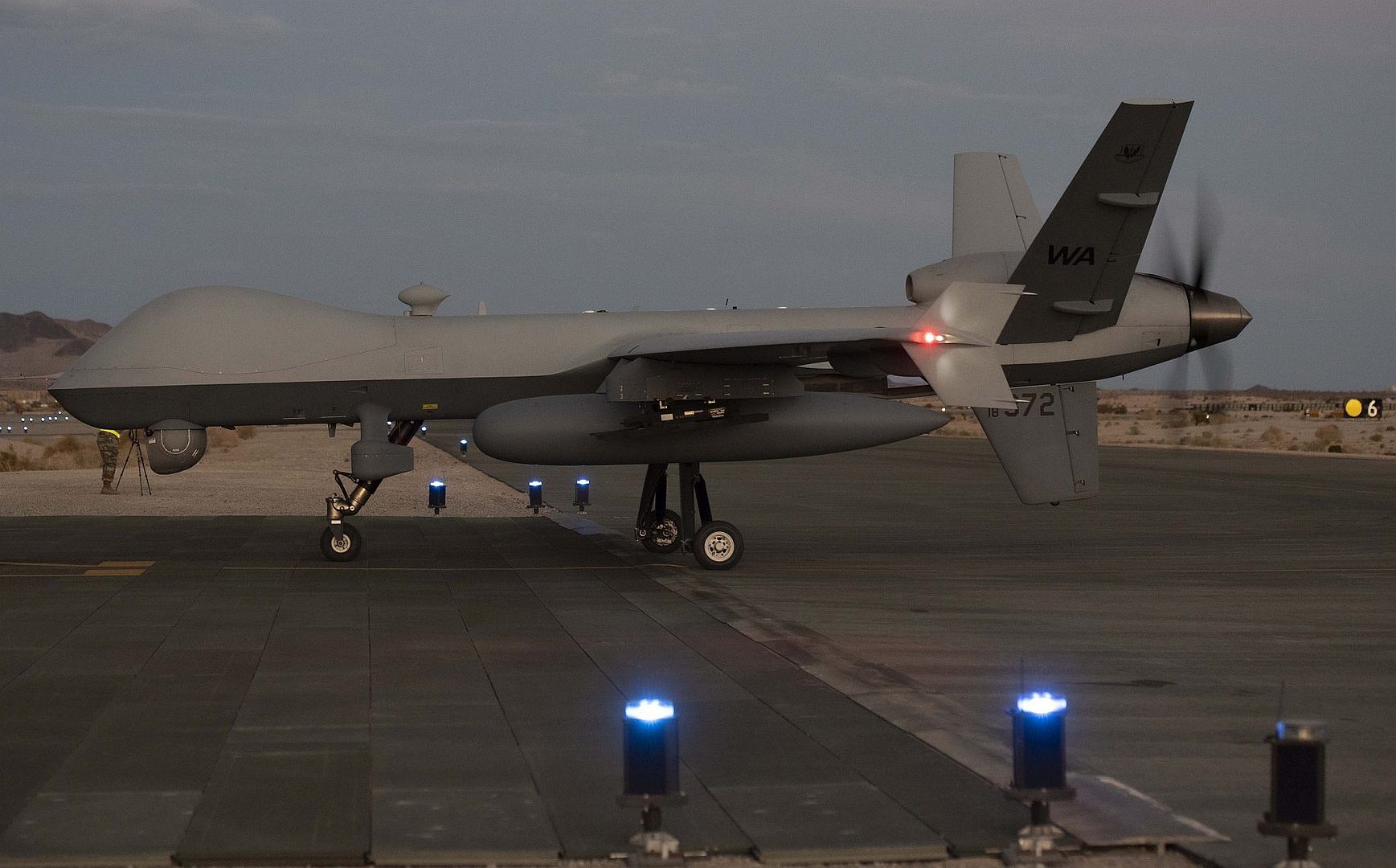
A U.S. Air Force F-16 Fighting Falcon, assigned to the Ohio National Guard’s 180th Fighter Wing, sits on the flightline before morning training flights, as part of exercise Northern Lightning, at Volk Field Air National Guard Base in Camp Douglas, Wis., Aug. 11, 2023. Northern Lightning is a joint training exercise, emphasizing user-defined objectives resulting in tailored, scenario-based, full spectrum, high-end training.
(U.S. Air National Guard photo by Staff Sgt. Kregg York)
Michael Kawashima, Yokota Aero Club instructor, left, and Nathan Van Ness, a student in the Aim High Flight Academy (AHFA), guide a Cessna 172M out of a hangar at Yokota Air Base, Japan, Aug. 10, 2023. The AHFA is a 15 day introductory flying program for high school and college students with interest in Air Force aviation, where the students practice flight simulation, learn different components of an aircraft, and learn how to fly a plane. (U.S. Air Force photos by Staff Sgt. Jessica Avallone)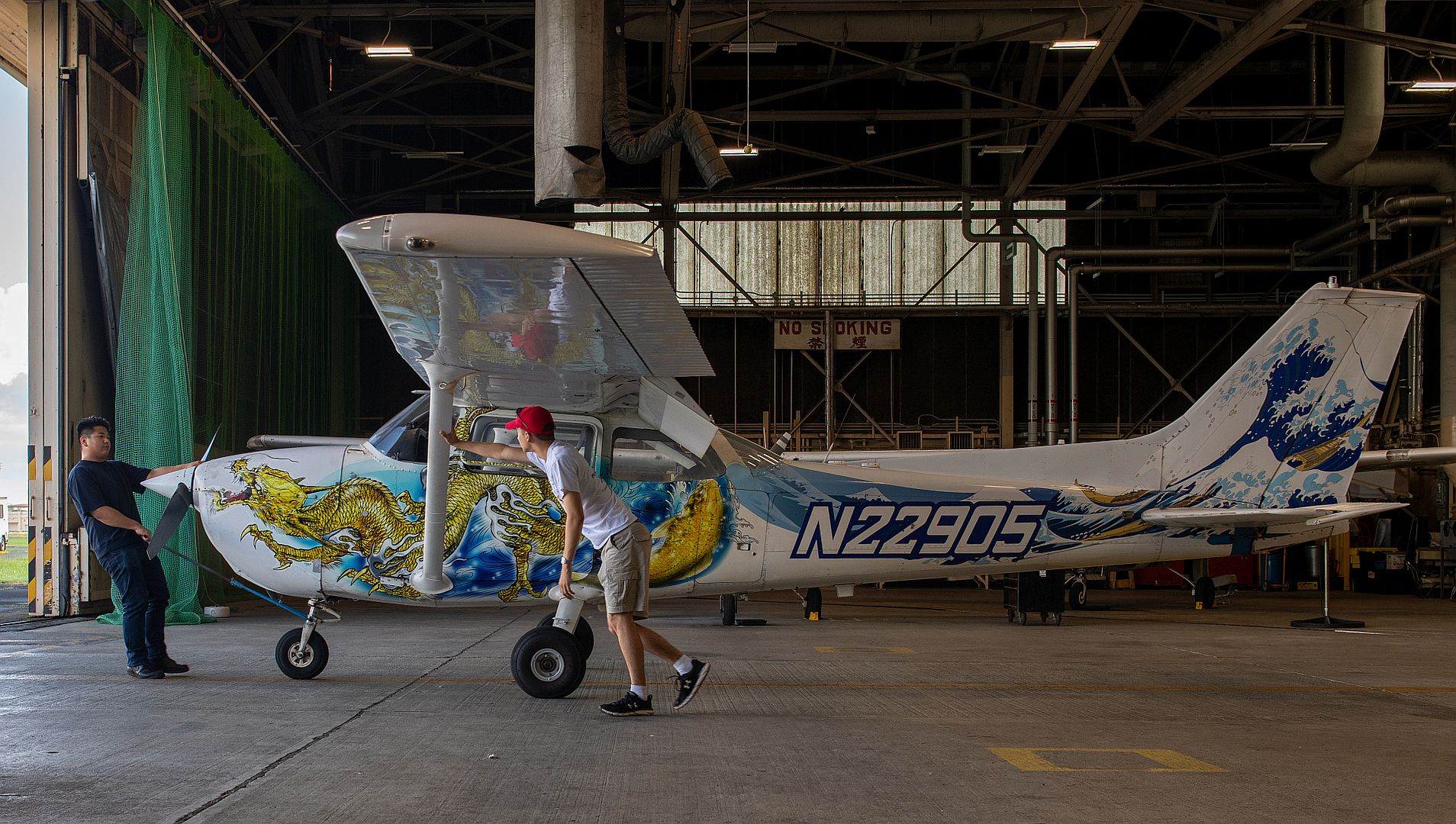

U.S. Air Force Senior Airman Jordan White, 74th Fighter Generation Squadron crew chief, checks an A-10C Thunderbolt II during Exercise RED-FLAG Rescue 23-2 at Davis-Monthan Air Force Base, Ariz., Aug. 18, 2023. White ensured every component of the aircraft was maintained to Air Force standards. (U.S. Air Force photo by Staff Sgt. Abbey Rieves)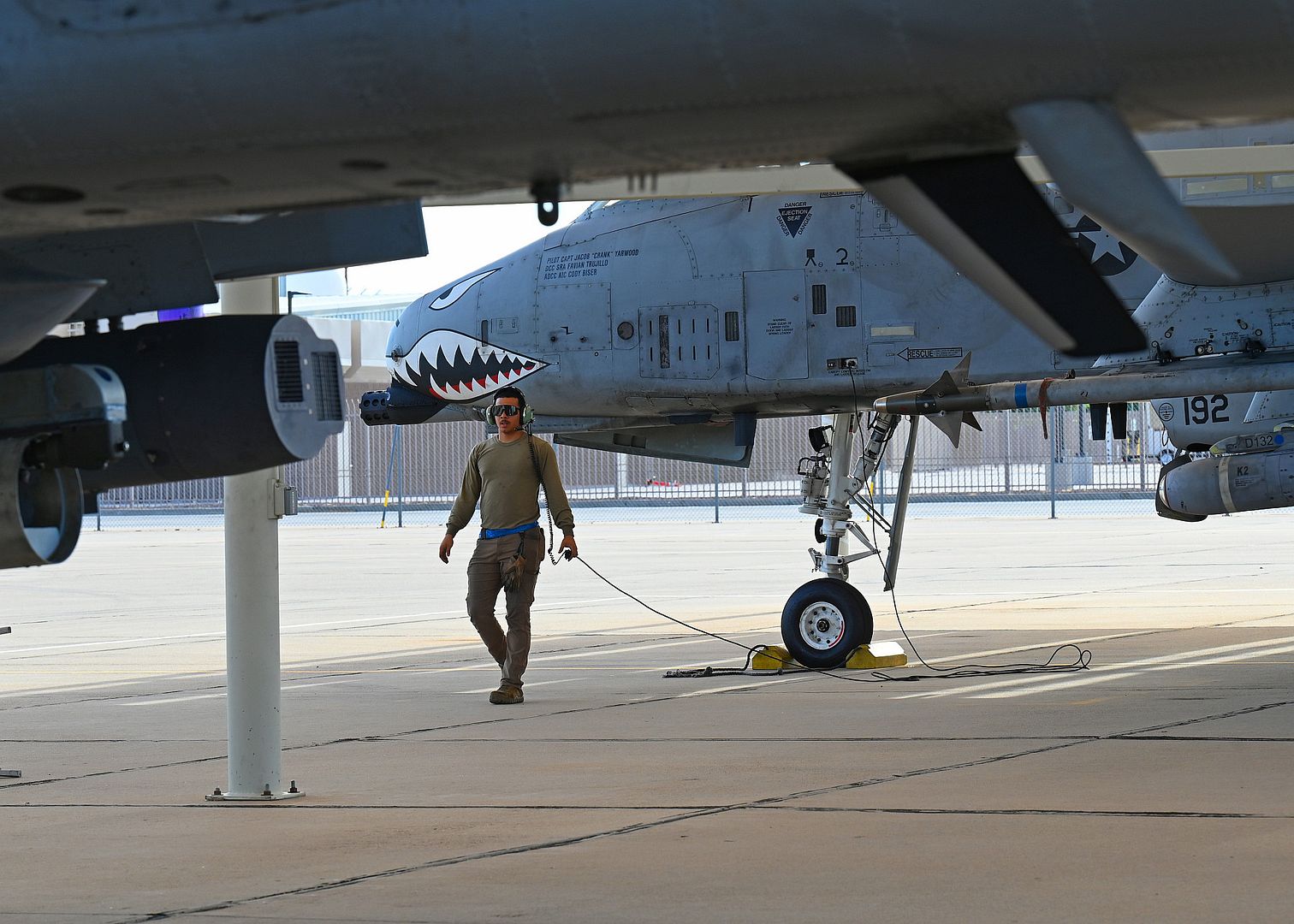
Arlington, Virginia – The U.S. Army awarded Airbus a $27.8 million contract to upgrade the Army National Guard Security & Support Battalion Mission Equipment Package (MEP).
Upgrades to the MEP expand the UH-72A Lakota’s capabilities to conduct day and night operations by providing an advanced moving map, enhanced digital interfaces, new monitors, an airborne mission management system and other system improvements.
“This award provides pilots with significantly increased functionality and capability to carry out today’s demanding missions, further enhancing the Lakota’s value as an ISR asset for the National Guard." said Scott Tumpak, Vice President of Military Line of Business for Airbus U.S. Space and Defense.
MEP equipped UH-72As are specifically designed to execute National Guard operations across a range of missions including domestic operations, counter-drug and border security.
The Army contract will retrofit up to 50 Security & Support Battalion aircraft deployed throughout the United States. There are currently 107 in the fleet.
These aircraft will be modified at Airbus’ Columbus, Mississippi helicopter production facility, where more than 480 UH-72A and UH-72B Lakota, based on the H145, have been delivered to the US Army since 2006.
The contract will be managed by Airbus U.S. Space & Defense. Operating under a Special Security Agreement, Airbus U.S. Space & Defense, Inc. offers world-class satellite, laser communication, rotor, and fixed wing solutions to meet the most complex U.S. defense, security, space, and intelligence requirements.
SAN DIEGO – 21 August 2023 – The Royal Netherlands Air Force (RNLAF) will double the number of MQ-9A Remotely Piloted Aircraft they will procure, taking the total order from four to eight aircraft. The first four MQ-9A Block 5 Reapers and associated Ground Control Stations were delivered to the RNLAF in 2022. MQ-9A is designed and developed by General Atomics Aeronautical Systems, Inc. (GA-ASI).
“We are doubling the number of MQ-9A Reapers so we can increase our maritime and overland intelligence, reconnaissance, surveillance (ISR) capacity,” said Lieutenant-Colonel Jan Ruedisueli, commander of the RNLAF’s 306 squadron that operate the new MQ-9A Reapers. “The MQ-9As will receive external pods for Electronic Intelligence, a communications relay, a Maritime Radar, and also be armed in the future.”
The delivery of the MQ-9As, their Ground Control Stations, and support equipment is part of a USAF Foreign Military Sale to the RNLAF.
“We’re thrilled that the first set of Dutch Reapers have made such a positive impact on the RNLAF,” said GA-ASI President David R. Alexander. “With this new set of capabilities, the Netherlands will have the most capable set of MQ-9 Block 5 aircraft in the world. They have customized the Dutch MQ-9As to meet the Netherlands’ expanding mission set.”
MQ-9A Block 5 has endurance of up to 27 hours, is capable of speeds up to 240 KTAS and can operate up to 40,000 feet. It has a 3,850-pound (1,746-kilogram) payload capacity that includes 3,000 pounds (1,361 kilograms) of external stores. It provides a long-endurance, persistent surveillance capability with Full-Motion Video and Synthetic Aperture Radar/Moving Target Indicator/Maritime Radar. An extremely reliable aircraft, MQ-9A Block 5 is equipped with a fault-tolerant flight control system and triple redundant avionics system architecture. It is engineered to meet and exceed manned aircraft reliability standards.
About GA-ASI
General Atomics Aeronautical Systems, Inc. (GA-ASI), an affiliate of General Atomics, is a leading designer and manufacturer of proven, reliable RPA systems, radars, and electro-optic and related mission systems, including the Predator® RPA series and the Lynx® Multi-mode Radar. With more than eight million flight hours, GA-ASI provides long-endurance, mission-capable aircraft with integrated sensor and data link systems required to deliver persistent situational awareness. The company also produces a variety of sensor control/image analysis software, offers pilot training and support services, and develops meta-material antennas.
For more information, visit www.ga-asi.com
-
 Main AdminU.S. Air Force Senior Airman Michael Azzone assigned to the 510th Fighter Generation Squadron, performs preventative maintenance on F-16 Fighting Falcon assigned to the 510th Fighter Squadron from Aviano Air Base, Italy, after arriving at Šiauliai Air Base, Lithuania, on Aug. 21, 2023 to participate in Astral Knight 23 Part 6, an Agile Combat Employment exercise. ACE exercises like AK23-6 tests the ability to quickly receive and integrate U.S. forces with NATO Allies and Partners while strengthening partnerships capable of decisively meeting today’s challenges. (U.S. Air Force photo by Tech. Sgt. Stephanie Longoria)
Main AdminU.S. Air Force Senior Airman Michael Azzone assigned to the 510th Fighter Generation Squadron, performs preventative maintenance on F-16 Fighting Falcon assigned to the 510th Fighter Squadron from Aviano Air Base, Italy, after arriving at Šiauliai Air Base, Lithuania, on Aug. 21, 2023 to participate in Astral Knight 23 Part 6, an Agile Combat Employment exercise. ACE exercises like AK23-6 tests the ability to quickly receive and integrate U.S. forces with NATO Allies and Partners while strengthening partnerships capable of decisively meeting today’s challenges. (U.S. Air Force photo by Tech. Sgt. Stephanie Longoria)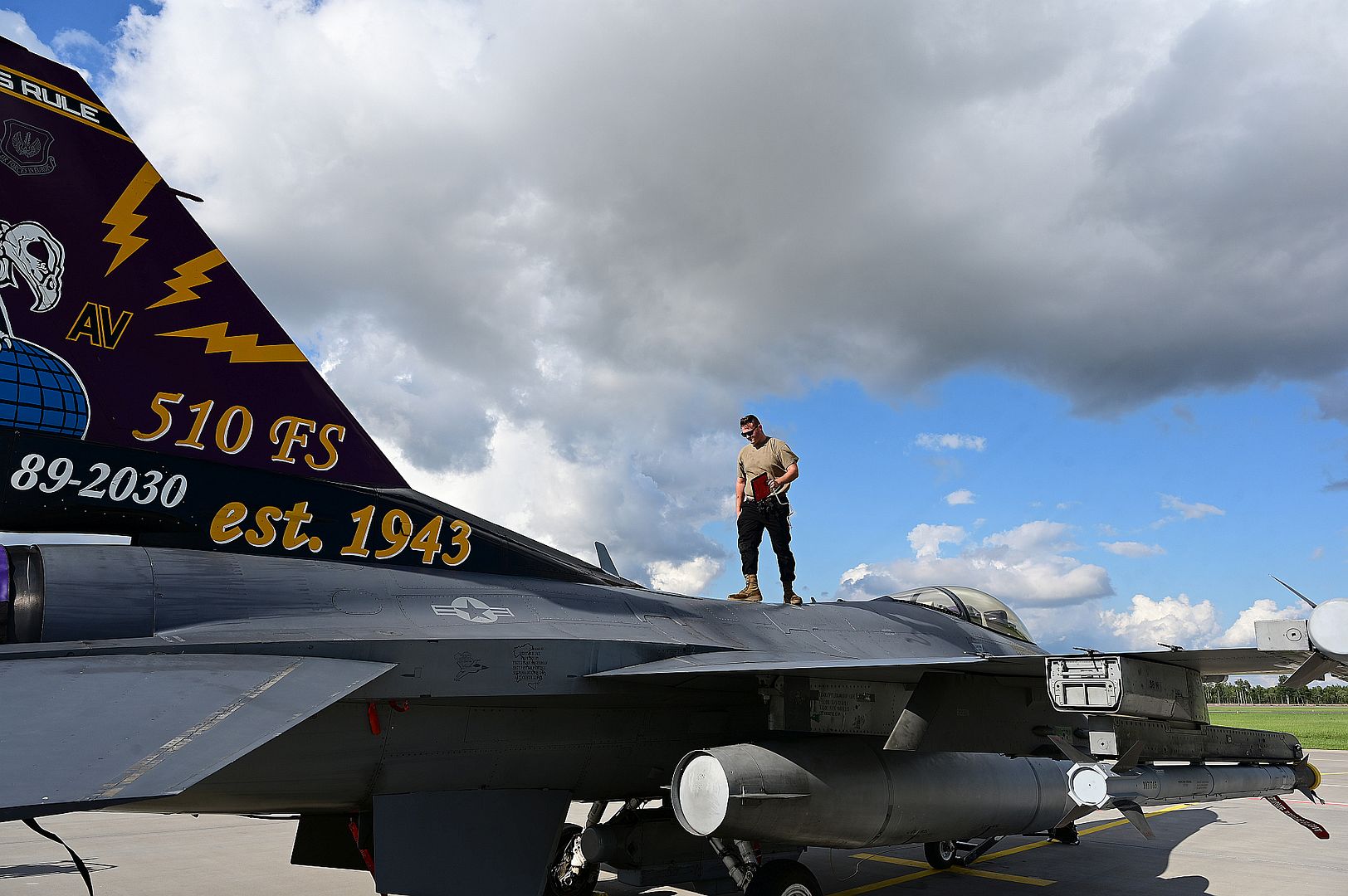
A U.S. Air Force F-35 Lightning II from the 493rd Fighter Squadron out of Royal Air Force Lakenheath, England, arrives at Šiauliai Air Base, Lithuania, on Aug. 21, 2023, to kick off Astral Knight 23 Part 6. AK23-6 provides opportunities for the U.S. to integrate alongside forces from the Baltic nations of Latvia and Lithuania and the Arctic nations of Finland and Sweden which builds a stronger coalition capable of deterring threats and aggression from adversaries throughout the regions. (U.S. Air Force photo by Tech. Sgt. Stephanie Longoria)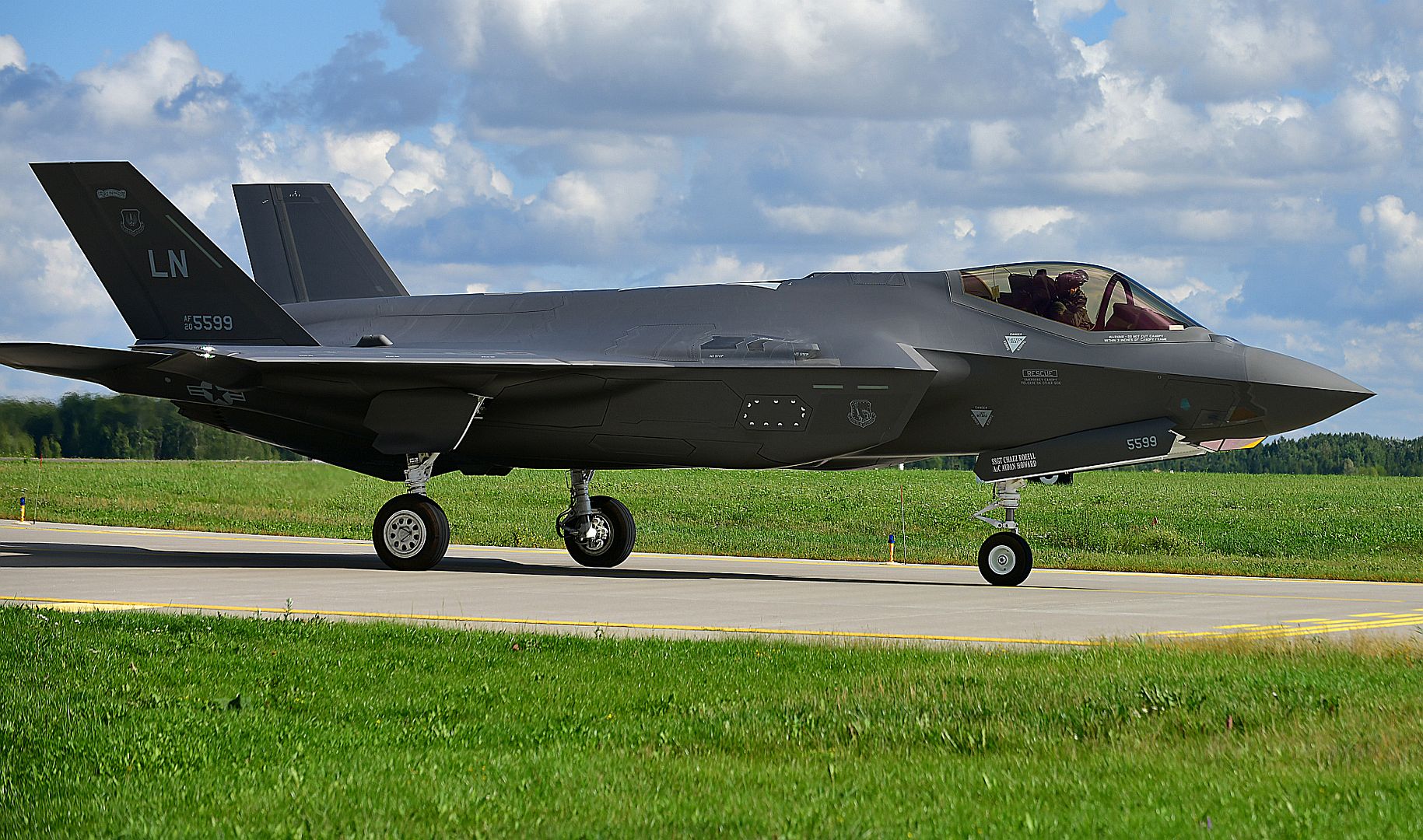
U.S. Air Force Senior Airman Eduardo Silva, 492nd Fighter Generation Squadron dedicated crew chief, marshals out an F-15E Strike Eagle at RAF Lakenheath, England, Aug. 22, 2023. The Liberty Wing's aircrews have the chance to enhance their experience and proficiency in supporting missions that bolster readiness, enhance NATO’s collective defense posture, and further integrate air capabilities with Allied and Partner nations. (U.S. Air Force photo by Airman 1st Class Austin Salazar)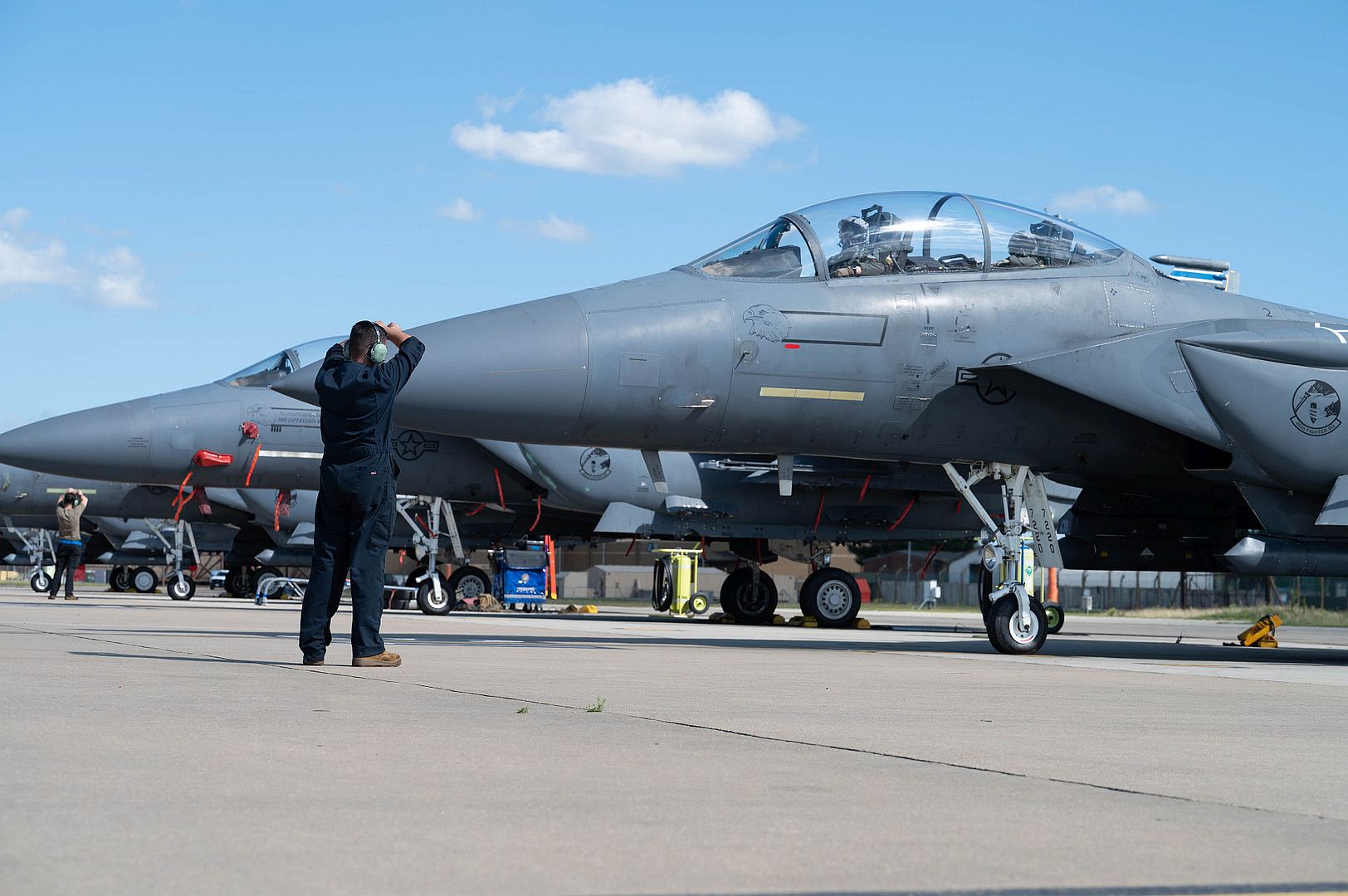
PHILIPPINE SEA (Aug. 22, 2023) An F/A-18F Super Hornet, attached to the Diamondbacks of Strike Fighter Squadron (VFA) 102, lands on the flight deck of the U.S. Navy’s only forward-deployed aircraft carrier, USS Ronald Reagan (CVN 76), in the Philippine Sea, August 22, 2023. The Diamondbacks conduct carrier-based air strikes and strike force escort missions, as well as ship, battle group, and intelligence collection operations. Ronald Reagan, the flagship of Carrier Strike Group 5, provides a combat-ready force that protects and defends the United States, and supports alliances, partnerships and collective maritime interests in the Indo-Pacific region. (U.S. Navy photo by Mass Communication Specialist 2nd Class Keyly Santizo)_102_lands_on_the_flight_deck_of_the_U.S._Navy_s_only_forward-deployed_aircraft_carrier_USS_Ronald_Reagan_kAUeYvPHeUCJXrjGGZBwAc.jpg?width=1920&height=1080&fit=bounds)
U.S. Seventh Air Force F-16 fighter aircraft joined Republic of Korea F-35A stealth fighters to conduct combined flight operations July 28, 2023, employing munitions at a live-fire training area off the west coast of the ROK. These types of events demonstrate the ROK and U.S. Air Forces’ continued interoperability and showcase their ability to provide commanders rapid and flexible response options if required. The U.S. remains committed to peace and prosperity through the region to secure a free and open Indo-Pacific and its ironclad commitment to the defense of the ROK. (ROK Air Force photos by Senior Master Sgt. Kwan-Young Hong)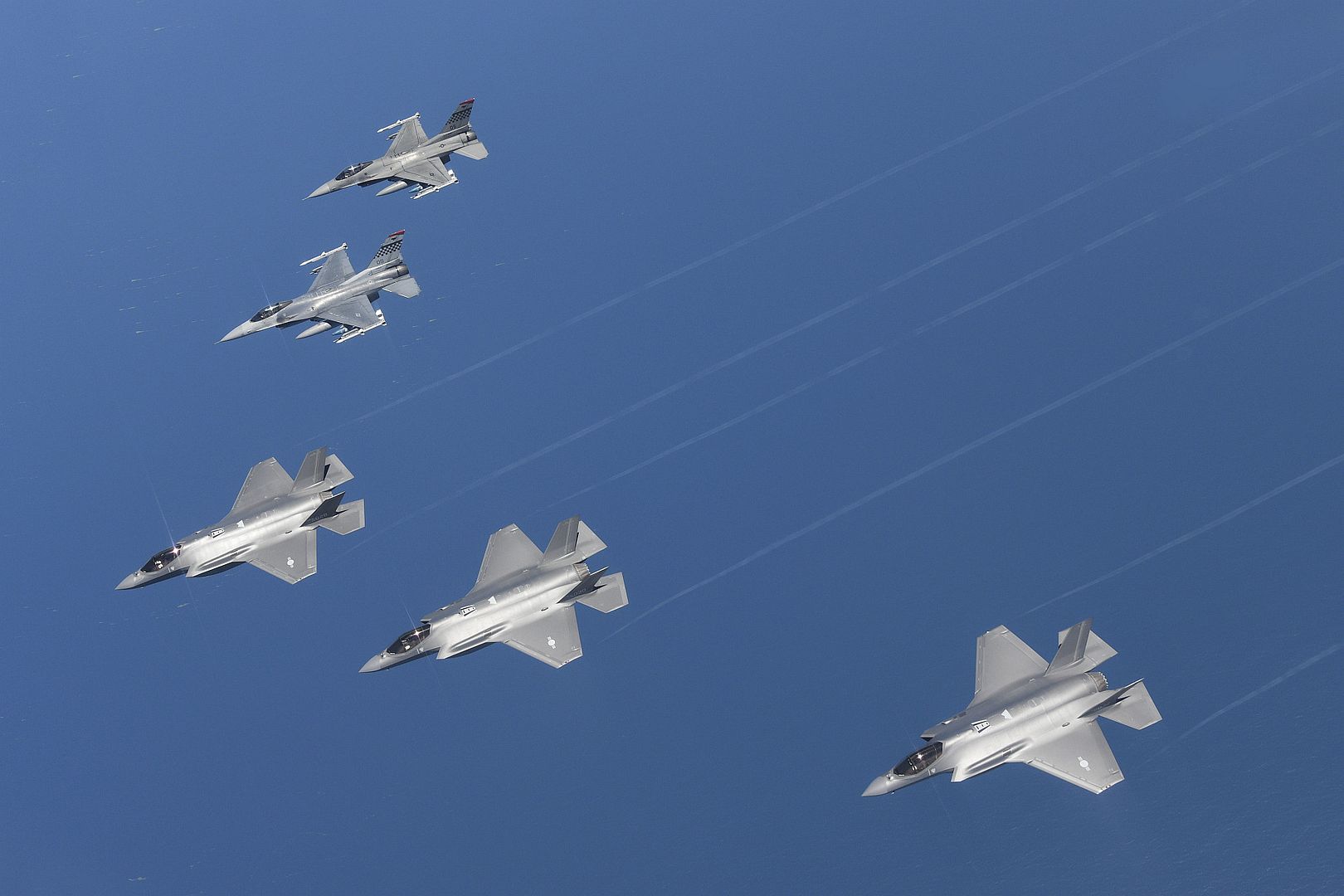

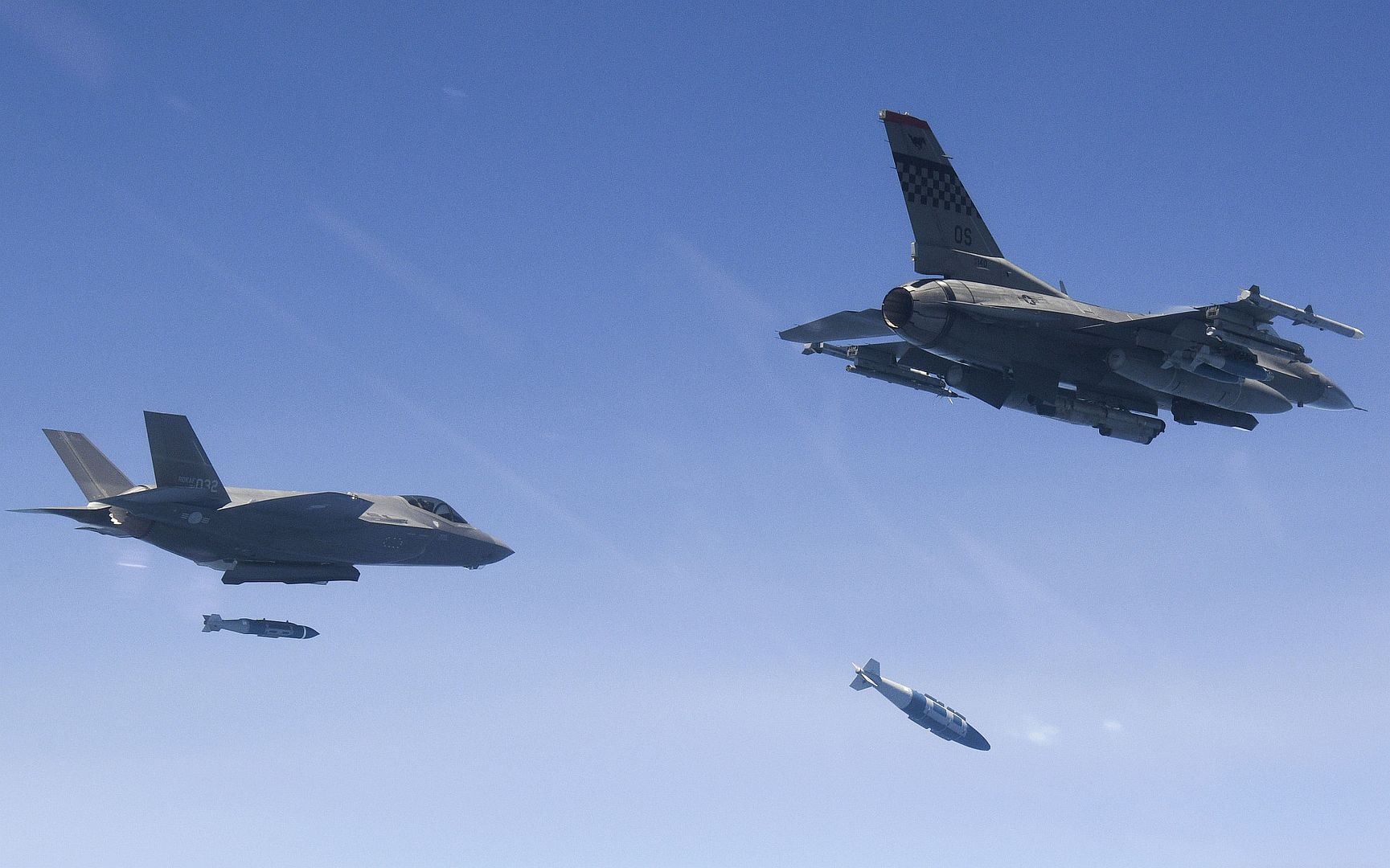
A Mirage F1, assigned to Airborne Tactical Advantage Company, starts its engine for a training flight, as part of exercise Northern Lightning, at Volk Field Air National Guard Base in Camp Douglas, Wis., Aug. 16, 2023. Northern Lightning is a joint training exercise, emphasizing user-defined objectives resulting in tailored, scenario-based, full spectrum, high-end training.
(U.S. Air National Guard photo by Staff Sgt. Kregg York)
A Mirage F1, assigned to Airborne Tactical Advantage Company, taxis to the runway after a training flight, as part of exercise Northern Lightning, in Camp Douglas, Wis., Aug. 9, 2023. Northern Lightning is a joint training exercise, emphasizing user-defined objectives resulting in tailored, scenario-based, full spectrum, high-end training.
(U.S. Air National Guard photo by Staff Sgt. Kregg York)
A Mirage F1, assigned to Airborne Tactical Advantage Company, sits on the flightline before morning training flights, as part of exercise Northern Lighting, at Volk Field Air National Guard Base in Camp Douglas, Wis., Aug. 11, 2023. Northern Lightning is a joint training exercise, emphasizing user-defined objectives resulting in tailored, scenario-based, full spectrum, high-end training.
(U.S. Air National Guard photo by Staff Sgt. Kregg York)
A U.S. Air Force F-35 Lightening II, assigned to the 33rd Fighter Wing, Eglin Air Force Base, Fla., sits on the flightline before morning training flights, as part of exercise Northern Lightning, at Volk Field Air National Guard Base in Camp Douglas, Wis., Aug. 16, 2023. Northern Lightning is a joint training exercise, emphasizing user-defined objectives resulting in tailored, scenario-based, full spectrum, high-end training.
(U.S. Air National Guard photo by Staff Sgt. Kregg York)
F-16 Fighting Falcons, assigned to the Ohio National Guard’s 180th Fighter Wing take off for a daily training mission, Aug. 16, 2023, from the 180FW in Swanton, Ohio. 180FW Airmen conduct daily training in realistic environments and circumstances to ensure they maintain the highest level of proficiency and readiness for worldwide deployment. (U.S. Air National Guard Photos by Senior Master Sgt. Beth Holliker).


ST. LOUIS, Aug. 21, 2023—The Republic of Indonesia and Boeing shared their commitment to finalize the sale of 24 F-15EX aircraft to Indonesia, subject to U.S. government approval, during a visit of Indonesia’s Minister of Defense Prabowo Subianto to the United States.
The signing of a Memorandum of Understanding (MoU) by Air Vice Marshal Yusuf Jauhari, Head of Defense Facilities Agency, Indonesia Ministry of Defense, and Mark Sears, Boeing Fighters vice president and program manager, took place today at the company’s St. Louis facility following a tour of the F-15EX production line.
“We are pleased to announce our commitment to procure the critical F-15EX fighter capability for Indonesia,” said Minister Subianto who witnessed the MoU signing. “This state-of-the-art fighter will protect and secure our nation with its advanced capabilities.”
The F-15EX is the most advanced version of the F-15 ever built, with digital fly-by-wire flight controls, a new electronic warfare system, an all-glass digital cockpit, and the latest mission systems and software capabilities, which will all be leveraged in delivering the new F-15IDN.
“We have invested years of expertise into developing the F-15EX capabilities. There is no other fighter like the F-15 in the world, and this platform will put Indonesia at the top of air dominance capabilities,” said Sears. “Boeing is ready to support this effort and remains a committed partner to the U.S. government in advancing international security objectives with allies and partners around the world.”
Boeing and Indonesia have worked in partnership for nearly 75 years to support the development of aerospace and defense capabilities in the country through training, supply chain development and collaborations. Today, Boeing’s presence in Indonesia covers commercial aviation, defense, space, supply chain, academia partnerships and talent development efforts across the local industry.
Currently the F-15 is operated by seven countries around the world.
# # #
As a leading global aerospace company, Boeing develops, manufactures and services commercial airplanes, defense products and space systems for customers in more than 150 countries. As a top U.S. exporter, the company leverages the talents of a global supplier base to advance economic opportunity, sustainability and community impact. Boeing's diverse team is committed to innovating for the future, leading with sustainability, and cultivating a culture based on the company's core values of safety, quality and integrity. Join our team and find your purpose at boeing.com/careers.
(Saint-Cloud, France, August 22, 2023) – Today, the European Aviation Safety Agency (EASA) issued the type certificate for Dassault’s Falcon 6X, followed by the U.S. Federal Aviation Administration (FAA).
These certifications conclude a more than two-year-long test campaign during which 1,500 flight hours were logged worldwide. It is a significant step on the path to entry into service for the Falcon 6X, with the first units undergoing final completion.
“The certification of the Falcon 6X is a remarkable milestone for Dassault Aviation. We would like to recognize the EASA and FAA certification teams for their commitment in this demanding process and our customers for their confidence. The Falcon 6X is the first brand new business jet to comply with the latest regulations, which will enhance the safety and security of all new aircraft,” said Eric Trappier, Chairman and CEO of Dassault Aviation. “The 5,500 nm / 10,200 km Falcon 6X combines the best qualities of Dassault Aviation’s world-leading business and fighter aircraft expertise to create the longest-range jet in its class with unparalleled passenger comfort and maximum mission flexibility”.
The Falcon 6X is the most spacious, advanced and versatile twinjet in the long-range business jet segment. It has been recognized with various design awards, including the Red Dot Award and the International Yacht & Aviation Award.
-
 Main AdminA U.S. Marine Corps F-35B Lightning II assigned to the Marine Fighter Squadron 214, of the 3rd Marine Aircraft Wing, Yuma, Arizona, awaits refueling from a KC-130J Super Hercules assigned to the Marine Aerial Refueler Transport Squadron 152, 1st Marine Aircraft Wing, Iwakuni, Japan, over the Joint Pacific-Alaska Range Complex during Red Flag-Alaska 23-3, Aug. 22, 2023. This exercise provides unique opportunities to integrate various forces into joint, coalition and multilateral training from simulated forward operating bases. (U.S. Air Force photo by Airman 1st Class Quatasia Carter)
Main AdminA U.S. Marine Corps F-35B Lightning II assigned to the Marine Fighter Squadron 214, of the 3rd Marine Aircraft Wing, Yuma, Arizona, awaits refueling from a KC-130J Super Hercules assigned to the Marine Aerial Refueler Transport Squadron 152, 1st Marine Aircraft Wing, Iwakuni, Japan, over the Joint Pacific-Alaska Range Complex during Red Flag-Alaska 23-3, Aug. 22, 2023. This exercise provides unique opportunities to integrate various forces into joint, coalition and multilateral training from simulated forward operating bases. (U.S. Air Force photo by Airman 1st Class Quatasia Carter)
PACIFIC OCEAN (Aug. 22, 2023) A C-2 Greyhound from the “Providers” of Fleet Logistics Support Squadron (VRC) 30 makes an arrested landing on the flight deck of the aircraft carrier USS Nimitz (CVN 68). Nimitz is underway conducting routine operations. (U.S. Navy photo by Mass Communication Specialist 2nd Class Justin McTaggart)_30_makes_an_arrested_landing_on_the_flight_deck_of_the_aircraft_carrier_USS_Nimitz_9Jpsxa1vfS7uRU4CDJVASt.jpg?width=1920&height=1080&fit=bounds)
PACIFIC OCEAN (Aug. 22, 2023) An MH-60R Sea Hawk helicopter from the “Battlecats” of Helicopter Maritime Strike Squadron (HSM) 73 hovers over the flight deck of the aircraft carrier USS Nimitz (CVN 68). Nimitz is underway conducting routine operations. (U.S. Navy photo by Mass Communication Specialist 2nd Class Kenneth Lagadi)_73_hovers_over_the_flight_deck_of_the_aircraft_carrier_USS_Nimitz.jpg?width=1920&height=1080&fit=bounds)
PACIFIC OCEAN (Aug. 22, 2023) An E-2C Hawkeye from the "Sun Kings" of Carrier Airborne Early Warning Squadron (VAW) 116 makes an arrested landing aboard the aircraft carrier USS Nimitz (CVN 68). Nimitz is underway conducting routine operations. (U.S. Navy photo by Mass Communication Specialist 2nd Class Carson Croom)_116_makes_an_arrested_landing_aboard_the_aircraft_carrier_USS_Nimitz.jpg?width=1920&height=1080&fit=bounds)
U.S. Air Force Senior Airman Andrew Cuevas (center), 510th Fighter Generation Squadron dedicated crew chief, performs a preflight inspection on an F-16 Fighting Falcon during exercise Astral Knight 23 Part 6 at Šiauliai Air Base, Lithuania, on Aug. 22, 2023. AK23-6 is an Agile Combat Employment exercise focusing on concepts designed to make us more agile in our execution, more resilient in sustaining our capability, and more lethal in delivering our combat power from austere and remote locations. (U.S. Air Force photo by Tech. Sgt. Stephanie Longoria)
U.S. Air Force Staff Sgts. Brian Raatz (front), and Zachary Lester, 510th Fighter Generation Squadron dedicated crew chiefs, perform a preflight inspection on an F-16 Fighting Falcon during exercise Astral Knight 23 Part 6 at Šiauliai Air Base, Lithuania, on Aug. 22, 2023. AK23-6 allows the U.S.to incorporate Agile Combat Employment concepts in less than optimal environments to improve interoperability among forces and increase capabilities. (U.S. Air Force photo by Tech. Sgt. Stephanie Longoria)
Three U.S. Air Force F-16 Fighting Falcons from the 52nd Fighter Wing, Spangdahlem Air Base, Germany, await air-to-air refueling on the wing-side of a KC-135 Stratotanker in support of Astral Knight 23 Part 6 over the Baltic Sea, Aug. 21, 2023. AK23-6 is a U.S.-led exercise that provides the opportunity to integrate with Arctic and Baltic Allies and Partners to build operational readiness and interoperability throughout the regions. (U.S. Air Force photo by Staff Sgt. Jesenia Landaverde)
A C-130J Super Hercules, assigned to the 19th Airlift Wing, taxis on the Pittsburgh International Airport Air Reserve Station flightline, Aug. 18, 2023. Its high visibility markings pay tribute to the 61st Airlift Squadron's Four Horseman C-130A demo team which operated from 1956 to 1960 with the same orange paint scheme. (U.S. Air Force photo by Master Sgt. Jeffrey Grossi)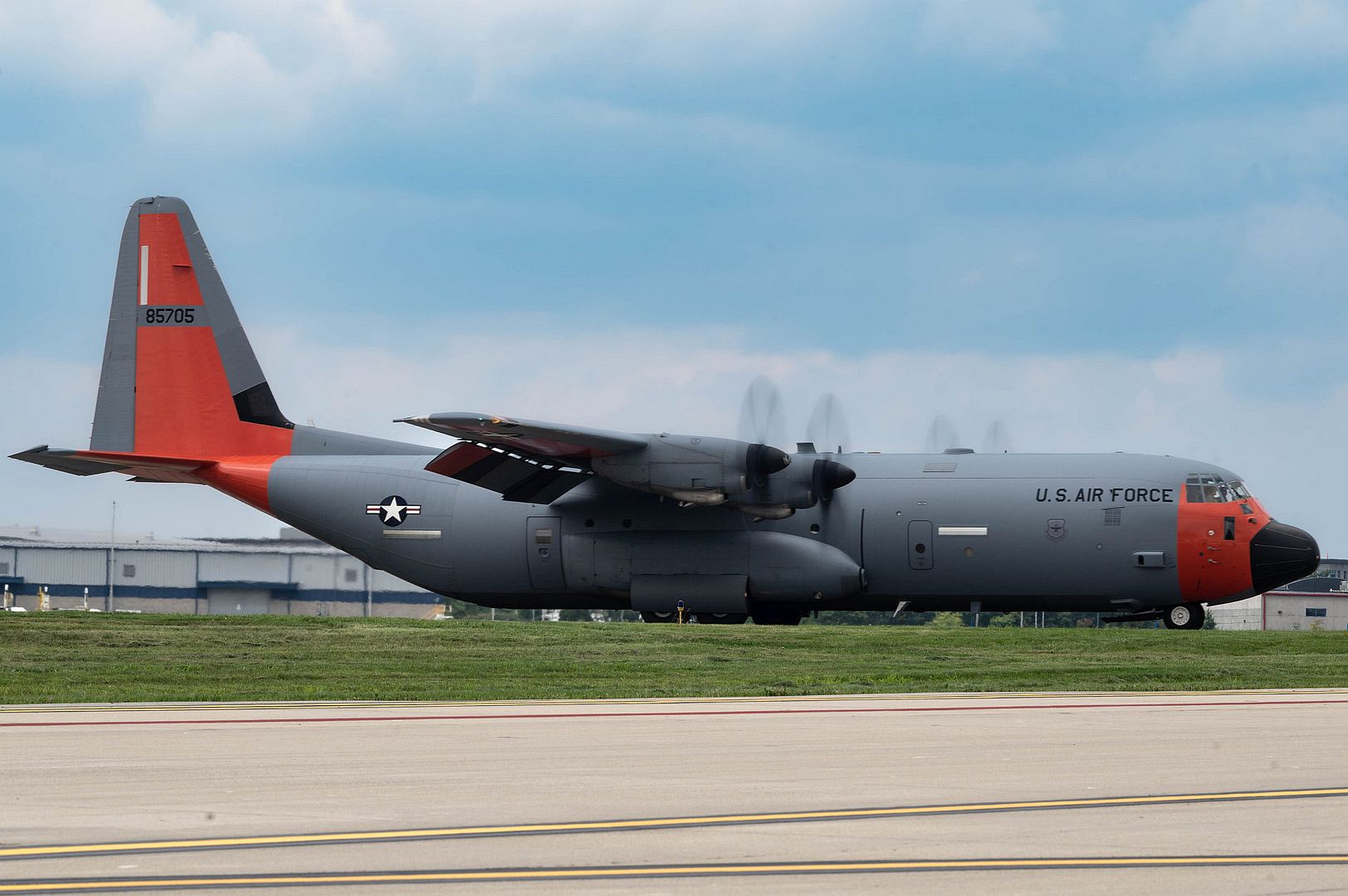
Two Royal Australian Air Force aircrew members walk to an E7-A Wedgetail during RED FLAG-Alaska 23-3 at Joint Base Elmendorf-Richardson, Alaska, Aug. 18, 2023. RF-A 23-3 enhances interoperability and strengthens practical cooperation between the United States Air Force and the RAAF. (U.S. Air Force photo by Staff Sgt. Derek Seifert)
Beijing, China, August 23rd, 2023 – Embraer E195-E2, the largest member of the E-Jet family, has been granted its Type Certificate by the Civil Aviation Administration of China (CAAC). This follows the certification of the E190-E2 received from CAAC in November last year, during the Zhuhai Air Show.
“We’re excited to now have both the E190-E2 and E195-E2 certified by CAAC, paving the way for sales in the Chinese market,” said Arjan Meijer, President and CEO of Embraer Commercial Aviation. “Our team in China is actively working with potential customers and making good progress. There are significant opportunities for the E2 in China, which offers complementary capacity to China’s indigenous ARJ21 and C919 aircraft; combined, they provide flexible, efficient, and eco-friendly options for Chinese airlines, meeting the demand of the world’s fast-growing air transportation market.”
According to Embraer’s latest 20-Year Market Outlook published in June, Asia Pacific including China is expected to show a strong growth rate, increasing its RPKs by 4.4% annually over the next 20 years. The need for flexibility, complementing narrow-body aircraft, is driving demand in the up-to-150-seat segment in China.
“It’s another milestone for the largest Embraer jet – the E195-E2 – to be certified by CAAC,” said Guo Qing, Managing Director and VP Commercial Aviation, Embraer China. “China is moving closer to carbon neutrality. The E195-E2 is the most environmentally efficient aircraft in its class. With a maximum of 146 seats, E195-E2 is the right size to profitably complement larger narrowbodies on lower density routes, connecting regional airports and offering travelers living in secondary and tertiary cities with one-stop access to routes worldwide.”
“With both the Chinese and Brazilian governments reiterating their support for Embraer’s activities in China during Brazilian President Lula’s State visit to China, I’m very optimistic about the opportunities in China,” Guo added.
Last year in November, Embraer E195-E2 ‘TechLion’ visited China and made its debut at the Zhuhai Airshow, exhibiting its capabilities to China’s aerospace leaders, including the outstanding performance, minimal noise and emissions, and low operation costs.
The E195-E2 entered into service in 2019 with Azul. As the largest member of the E-Jet family, E195-E2 accommodates between 120 and 146 passengers. It is the most fuel-efficient single aisle aircraft flying today, delivering 25% better fuel efficiency per seat, compared to previous generation E-Jets.
In June 2022, the E195-E2 was successfully tested on 100% SAF, confirming that the E-Jets E2 family can fly with blends of up to 100% SAF without any compromise to safety or performance. Today, the E2 emits 25% fewer CO2 emissions compared to previous generation aircraft; this reduction can be increased to 85% with SAF.
2023 marks Embraer’s 23rd year in China. In September 2000, the first Embraer ERJ145 was delivered to Sichuan Airlines, and in May 2008, Embraer delivered its first E-Jet, an E190, to Tianjin Airlines. Today, there are 85 E-Jets flying with Tianjin Airlines, Hebei Airlines, Beibu Gulf Airlines, Colorful Guizhou Airlines in China. The E-Jet fleet played an important role in the Covid-19 period to maintain key routes and help the industry to recover.
Data shows China’s civil aviation market continues its recovery, fueled by rising domestic demand. According to CAAC, in the first five-month of 2023, China domestic passenger traffic volume reached 224.8 million, up 135 percent compared with 2022. The domestic market has already exceeded the 2019 level since April 2023 due to pent-up demand following the pandemic.
Last month, Embraer signed a Letter of Agreement at the 54th Paris Airshow with Lanzhou Aviation Industry Development Group for 20 E190F and E195F E-Jets Passenger-to-Freight Conversions (P2F). Embraer and Lanzhou intend to cooperate on establishing of E190F and E195F conversion capability in Lanzhou, which will support and accelerate the introduction of E-Jet first generation freighters to Chinese market.
Embraer has also established a comprehensive after-sales service and support system in China, including authorized maintenance centers, spare parts warehouses, and complete pilot training network. It has laid a solid foundation for the new generation of E2 family to operate in China.
The RAF has worked with the United States Air Force to test and validate ‘hot’ refuelling procedures for the RC-135 Rivet Joint aircraft.
Hot refuelling is when an aircraft is refuelled after landing with an engine running. The RC-135 is not equipped with an aircraft power unit which limits its ability to conduct organic refuel operations without the support of a ground power unit. Hot refuelling reduces ground downtime, increases reliability, and enables operations away from main operating bases.
“We’re looking at ways of increasing our quick reaction capability for Rivet Joint and ACE is the perfect way to do this,” said Flight Lieutenant Dan Wilkes of 51 Squadron. “Hot pit refuelling will allow us to ‘turn and burn’ the jet in a drastically reduced time and push the aircraft towards its peak performance operationally.”
(Photos courtesy of the USAF)
-
 Main AdminTwo U.S. Air Force Airmen from the 432nd Aircraft Maintenance Squadron put chalks on an MQ-9 Reaper remotely piloted aircraft after it landed at Marine Base Camp Pendleton, Aug. 22, 2023. This was the first time an MQ-9 landed at Marine Base Camp Pendleton during the Agile Combat Employment (ACE) exercise Agile Hunter which increased joint interoperability between the U.S. Air Force and U.S. Marine Corps. (U.S. Air Force photo by Airman 1st Class Victoria Nuzzi)
Main AdminTwo U.S. Air Force Airmen from the 432nd Aircraft Maintenance Squadron put chalks on an MQ-9 Reaper remotely piloted aircraft after it landed at Marine Base Camp Pendleton, Aug. 22, 2023. This was the first time an MQ-9 landed at Marine Base Camp Pendleton during the Agile Combat Employment (ACE) exercise Agile Hunter which increased joint interoperability between the U.S. Air Force and U.S. Marine Corps. (U.S. Air Force photo by Airman 1st Class Victoria Nuzzi)
An MQ-9 Reaper remotely piloted aircraft lands at Marine Base Camp Pendleton on Aug. 22, 2023. This was the first time an MQ-9 landed at Marine Base Camp Pendleton during the Agile Combat Employment (ACE) exercise Agile Hunter which increased joint interoperability between the U.S. Air Force and U.S. Marine Corps. (U.S. Air Force photos by Airman 1st Class Victoria Nuzzi)

A Turkish Air Force C-130 cargo plane drops a heavy equipment package during a Joint readiness demonstration as part of Exercise Agile Spirit 23 Aug. 22, 2023 at Kayseri, Türkiye. Exercise Agile Spirit 23 is designed to support theater security cooperation and interoperability among NATO Allies and partners to improve joint and multinational readiness, scale, and capabilities by exercising rapid mobility and posture combat credible forces across the European theater to the country of Georgia to bolster their defense efforts and deter aggression in the Black Sea region while exercising the enduring U.S. State Partnership Program with the Georgia Army National Guard. (U.S. Air Force photo by Staff Sgt. Peter Reft)
PACIFIC OCEAN (Aug. 23, 2023) An F/A-18F Super Hornet from the "Mighty Shrikes" of Strike Fighter Squadron (VFA) 94 touches down on the flight deck of the aircraft carrier USS Nimitz (CVN 68). Nimitz is underway conducting routine operations. (U.S. Navy photo by Mass Communication Specialist Second Class Carson Croom)_94_touches_down_on_the_flight_deck_of_the_aircraft_carrier_USS_Nimitz.jpg?width=1920&height=1080&fit=bounds)
PACIFIC OCEAN (Aug. 23, 2023) An F/A-18F Super Hornet from the "Fighting Redcocks" of Strike Fighter Squadron (VFA) 22 taxis on the flight deck of the aircraft carrier USS Nimitz (CVN 68). Nimitz is underway conducting routine operations. (U.S. Navy photo by Mass Communication Specialist Second Class Carson Croom)_22_taxis_on_the_flight_deck_of_the_aircraft_carrier_USS_Nimitz_davF1gzaQoJs97sHLzVfSU.jpg?width=1920&height=1080&fit=bounds)
An Israeli Air Force refueling aircraft gets ready for take-off after stopping overnight at Royal Air Force Mildenhall, England, Aug. 16, 2023. Team Mildenhall provided support to the transiting aircraft and crew, helping strengthen international relations and cooperation between our allied nations. Having the ability to provide vital support to other nations’ aircraft shows the importance of our geographic location and global reach we are able to provide at any time to our allies. (U.S. Air Force photos by Airman 1st Class Katie Mullikin)
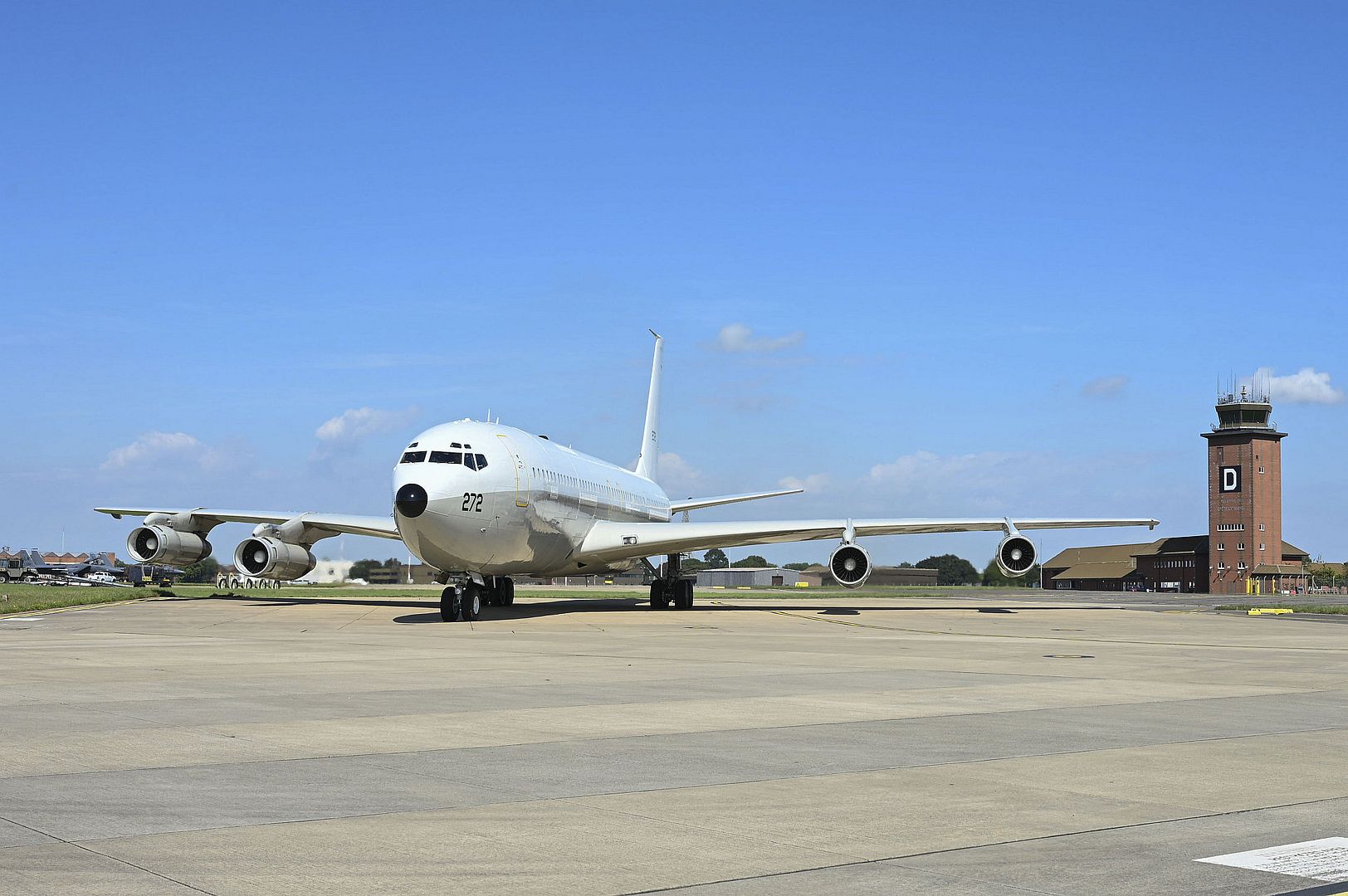
Two U.S. Air Force F-16 Fighting Falcons assigned to the 18th Aggressor Squadron, Eielson Air Force Base, Alaska fly next to a KC-46A Pegasus assigned to the 133rd Aerial Refueling Squadron, Pease Air Force Base, New Hampshire, during RED FLAG-Alaska 23-3 over the Joint Pacific-Alaska Range Complex, Alaska, Aug. 18, 2023. The 18th Aggressor Squadron supports Red Flag-Alaska by contributing knowledge of adversarial tactics, techniques, and procedures to participating units. (U.S. Air Force photos by Airman 1st Class Andrew Britten)


A U.S. Air Force F-22 Raptor assigned to the 3rd Wing, Joint Base Elmendorf-Richardson, Alaska, flies next to a KC-46A Pegasus assigned to the 133rd Aerial Refueling Squadron, Pease Air Force Base, New Hampshire, during RED FLAG-Alaska 23-3 over the Joint Pacific-Alaska Range Complex, Alaska, Aug. 18, 2023. RF-A serves as an ideal platform for international engagement, and the exercise has a long history of including allies and partners. This enables all involved to exchange tactics, techniques and procedures while improving interoperability. (U.S. Air Force photo by Airman 1st Class Andrew Britten)
DENVER, August 24, 2023 — Boom Supersonic, the company building the world’s fastest airliner, Overture, today announced it has completed several key milestones for XB-1, Boom’s technology demonstrator aircraft. XB-1 leverages 60 years of progress in airplane technologies like carbon fiber composites, advanced avionics, and digitally-optimized aerodynamics to enable sustainable supersonic travel.
Earlier this year, XB-1 was moved from the company’s hangar in Centennial, Colorado to the Mojave Air & Space Port in Mojave, California to continue preparations for flight. The aircraft has undergone extensive ground testing since arriving, including taxi testing this week.
“The recent progress made towards XB-1’s first flight reflects the team’s collective efforts to build and safely fly the world’s first independently developed supersonic jet,” said Blake Scholl, Boom Supersonic’s founder and CEO.
In addition to the ongoing testing, XB-1 recently received an experimental airworthiness certificate from the Federal Aviation Administration (FAA), following a detailed aircraft inspection. Boom has also secured letters of authorization to allow Chief Test Pilot Bill “Doc” Shoemaker and test pilot Tristan “Gepetto” Brandenburg to fly XB-1. Additionally, letters of agreement with airspace authorities are in place allowing for flights of the aircraft over the Mojave desert. XB-1’s historic first flight will occur in the same airspace where Captain Charles “Chuck” Yeager first broke the sound barrier in the Bell X-1 and the Mach 3+, strategic reconnaissance SR-71 “Blackbird” first flew in 1964.
XB-1 has provided the company with valuable learnings, including the development of a robust safety culture. In preparation for flight, Boom’s test pilots have completed hundreds of hours in the simulator for aircraft evaluation, operations development, training, and human factors assessments to achieve the highest levels of safety. The test pilots also maintain flight proficiency in a T-38 trainer aircraft, the same aircraft that will be used as a chase plane for all flight tests of XB-1. To further increase safety, the test pilots will use the T-38 to practice formation flying.
“It’s fitting that XB-1 is now progressing toward first flight at the Mojave Air & Space Port, home to more than 50 first flights and other significant aviation events,” said Bill “Doc” Shoemaker, Chief Test Pilot for Boom Supersonic. “I’m looking forward to flying XB-1 here, building on the achievements of other talented engineers and pilots who inspire us every day to make supersonic travel mainstream.”
XB-1 features a carbon composite and titanium fuselage measuring 71 feet in length. Its ogive (modified delta) wing enables safe operation at takeoff and landing as well as supersonic speeds. The three General Electric J85 engines that power XB-1 produce a combined maximum thrust of 12,300 pounds of force (lbf).
The supersonic demonstrator aircraft rolled out of Boom’s hangar in Centennial, Colorado in October 2020. Since then, rigorous testing of all of XB-1’s internal subsystems has been completed. Upgraded landing gear and supersonic engine intakes were also installed on XB-1, both of which increase performance and safety.
Across its development, XB-1 has validated Boom’s approach to airplane design and enabled engineers to leverage advanced tools like computational fluid dynamics (CFD) which are critical components of Overture’s development. Overture is the sustainable supersonic airliner from Boom that will fly at Mach 1.7, or about twice the speed of today’s fastest airliners, and is designed to run on 100% sustainable aviation fuel (SAF).
To view XB-1’s recent taxi testing please visit the Boom Supersonic YouTube channel.
For more information about XB-1 please visit: https://boomsupersonic.com/xb-1
About Boom Supersonic
Boom Supersonic is transforming air travel with Overture, the world’s fastest airliner, optimized for speed, safety, and sustainability. Serving both civil and government markets, Overture will fly at twice the speed of today’s airliners and is designed to run on 100% sustainable aviation fuel (SAF). The company has secured SAF offtake agreements from Dimensional Energy and AIR COMPANY, bringing its total to 10 million gallons of SAF per year for Overture’s net zero carbon flight test program. Overture’s order book, including orders and pre-orders from American Airlines, United Airlines, and Japan Airlines stands at 130 aircraft. Boom is working with Northrop Grumman for government and defense applications of Overture. Suppliers and partners collaborating with Boom on the Overture program include Aernnova, Leonardo, Aciturri, Safran Landing Systems, Eaton, Collins Aerospace, and the United States Air Force.
Symphony™ is the propulsion system that will power Overture, a Boom-led collaboration with world-class partners including Florida Turbine Technologies (FTT), a business unit of Kratos Defense & Security Solutions, Inc., GE Additive and StandardAero. For more information, visit https://boomsupersonic.com.
SEATTLE, Aug. 23, 2023 /PRNewswire/ -- Boeing [NYSE: BA] and the Qantas Group announced today the carrier has selected the 787 Dreamliner family to modernize its widebody fleet with an order for four 787-9 and eight 787-10 airplanes. With enhanced fuel efficiency and environmental performance, the 787 Dreamliner is pivotal to Qantas' global growth strategy to reduce its carbon emissions over the next decade and beyond.
"This is another multi-billion-dollar investment in the national carrier, and it's great news for our customers and our people," said Alan Joyce, Qantas Group CEO. "The 787 and the GE engines fitted to them, are thoroughly proven and extremely capable."
The 787 enables Qantas to meet its near- and long-term sustainability goals, reducing fuel use and emissions by up to 25% and featuring quieter engines compared to previous generation jets. The airplanes are also capable of flying on a blend of Sustainable Aviation Fuel (SAF), an important pathway to reducing emissions. The new order is part of Qantas' major fleet renewal program that is significantly increasing the carrier's overall fuel efficiency each year.
"With its market-leading environmental performance, the 787 Dreamliner is central to Qantas' unwavering commitment to operate one of the most sustainable and capable fleets in the airline industry," said Stan Deal, president and CEO of Boeing Commercial Airplanes. "Both the 787-9 and 787-10 offer enhanced efficiency, flexibility and passenger comfort to connect Australia and destinations around the world."
Capable of flying an expansive international route network, the operating economics of the 787 family enables Qantas to open new routes and add more flights to its existing network. The 787-9 can fly up to 7,565 nautical miles (14,010 km) connecting Australia to North America and Europe. The larger 787-10 with a range of 6,330 nautical miles (11,730 km), will enable the airline to serve many popular international and regional routes. Currently, Qantas has a fleet of 14 787-9 jets.
As a leading global aerospace company, Boeing develops, manufactures and services commercial airplanes, defense products and space systems for customers in more than 150 countries. As a top U.S. exporter, the company leverages the talents of a global supplier base to advance economic opportunity, sustainability and community impact. Boeing's diverse team is committed to innovating for the future and living the company's core values of safety, quality and integrity. Learn more at www.boeing.com.
-
 Main AdminMembers of the aviation fuel handling team refuel an MH-65E Dolphin helicopter during routine nighttime flight operations onboard U.S. Coast Guard Cutter Munro (WMSL 755) Aug. 23, 2023, in the South China Sea. Munro is deployed to the Indo-Pacific to advance relationships with ally and partner nations to build a more stable, free, open, and resilient region with unrestricted, lawful access to the maritime commons. (U.S. Navy photos by Chief Petty Officer Brett Cote)
Main AdminMembers of the aviation fuel handling team refuel an MH-65E Dolphin helicopter during routine nighttime flight operations onboard U.S. Coast Guard Cutter Munro (WMSL 755) Aug. 23, 2023, in the South China Sea. Munro is deployed to the Indo-Pacific to advance relationships with ally and partner nations to build a more stable, free, open, and resilient region with unrestricted, lawful access to the maritime commons. (U.S. Navy photos by Chief Petty Officer Brett Cote)_Aug._23_2023-1.jpg?width=1920&height=1080&fit=bounds)
_Aug._23_2023.jpg?width=1920&height=1080&fit=bounds)
An HH-60G Pave Hawk search and rescue helicopter assigned to the 106th Rescue Wing based on Francis S. Gabreski Air National Guard Base in Westhampton Beach, N.Y., approaches a C-130J Combat King II search and rescue aircraft, also assigned to the 106th Rescue Wing, for an air-refueling over Campo Grande, Brazil, August 23, 2023. The air-refueling is taking place as part of Exercise Tapio which is being conducted as part of the New York National Guard’s State Partnership with Brazil. (U.S. Air National Guard photo by Airman 1st Class Sarah McKernan)
PHILIPPINE SEA (Aug. 24, 2023) An F/A-18E Super Hornet, attached to the Eagles of Strike Fighter Squadron (VFA) 115, launches off the flight deck of the U.S. Navy’s only forward-deployed aircraft carrier, USS Ronald Reagan (CVN 76), during flight operations in the Philippine Sea, Aug. 24, 2023. The Eagles conduct carrier-based air strikes and strike force escort missions, as well as ship, battle group, and intelligence collection operations. Ronald Reagan, the flagship of Carrier Strike Group 5, provides a combat-ready force that protects and defends the United States, and supports alliances, partnerships and collective maritime interests in the Indo-Pacific region. (U.S. Navy photo by Mass Communication Specialist 2nd Class Daniel Providakes)_115_launches_off_the_flight_deck_of_the_U.S._Navy_s_only_forward-deployed_aircraft_carrier_USS_Ronald_Reagan.jpg?width=1920&height=1080&fit=bounds)
Two U.S. Air Force KC-10 Extenders perform refueling training over Northern California, Aug. 23, 2023. Although the KC-l0’s primary mission is aerial refueling, it can combine the tasks of a tanker and cargo aircraft by refueling fighters while simultaneously carrying support personnel and equipment. (U.S. Air Force photo by Tech. Sgt. Levi Reynolds)
A U.S. Air Force MC-130J Commando II from the 15th Special Operations Squadron participates at the Joint Pacific-Alaska Range Complex during Red Flag-Alaska 23-3 on Eielson Air Force Base, Alaska, Aug. 15-24, 2023. Red Flag-Alaska serves as a platform for international engagement and the exercise has a long history of including Allies and partners. This enables all involved to exchange tactics, techniques and procedures while improving interoperability. (U.S. Air Force Photos by Airman Carson Jeney)

U.S. Airmen assigned to the 493rd Fighter Generation Squadron recover a U.S. Air Force F-35 Lightning II assigned to the 493rd Fighter Squadron from Royal Air Force Lakenheath, England, at Šiauliai Air Base runway in Lithuania, on Aug. 24, 2023, during Astral Knight 23 Part 6. AK23-6 provides opportunities for the U.S. to integrate alongside forces from the Baltic nations of Latvia and Lithuania and the Arctic nations of Finland and Sweden which builds a stronger coalition capable of deterring threats and aggression from adversaries throughout the regions. (U.S. Air Force photo by Tech. Sgt. Stephanie Longoria)
A U.S. Air Force F-16 Fighting Falcon assigned to the 510th Fighter Squadron out of Aviano Air Base, Italy, taxis at Šiauliai Air Base, Lithuania, on Aug. 23, 2023, during Astral Knight 23 Part 6. AK23-6 allows the U.S. to posture for evolving conditions in forward locations, while also consulting with NATO Allies and Partners on deterrence and defense postures. (U.S. Air Force photo by Tech. Sgt. Stephanie Longoria)
Royal Australian Air Force Cpl. David Tex Walker, No. 77 Squadron aircraft technician, waits to proceed with pre-flight procedures during Red Flag-Alaska 23-3 at Eielson Air Force Base, Alaska, Aug. 23, 2023. Red Flag serves as an ideal platform for international engagement and the exercise has a long history of including allies and partners. This enables all involved to exchange tactics, techniques and procedures while improving interoperability. (U.S. Air Force photo by Senior Airman Megan Estrada)
An EA-18G Growler assigned to the Electronic Attack Squadron 134, from Naval Air Station Whidbey Island, Washington, taxis out for a mission during Red Flag-Alaska 23-3 at Eielson Air Force Base, Alaska, Aug. 22, 2023. Members from the Royal Australian Air Force, U.S. Air Force, U.S. Marine Corps and U.S. Navy participated in this exercise, which serves as an ideal platform for international engagement and enables all involved to exchange tactics, techniques and procedures while improving interoperability. (U.S. Air Force photo by Senior Airman Megan Estrada)
An EA-18G Growler assigned to the Electronic Attack Squadron 134, from Naval Air Station Whidbey Island, Washington, takes off for a mission during Red Flag-Alaska 23-3, at Eielson Air Force Base, Alaska, Aug. 22, 2023. Integrating the U.S. Air Force and U.S. Navy strengthens joint planning, communication and execution to enhance interoperability and joint operational effectiveness. (U.S. Air Force photo by Senior Airman Megan Estrada)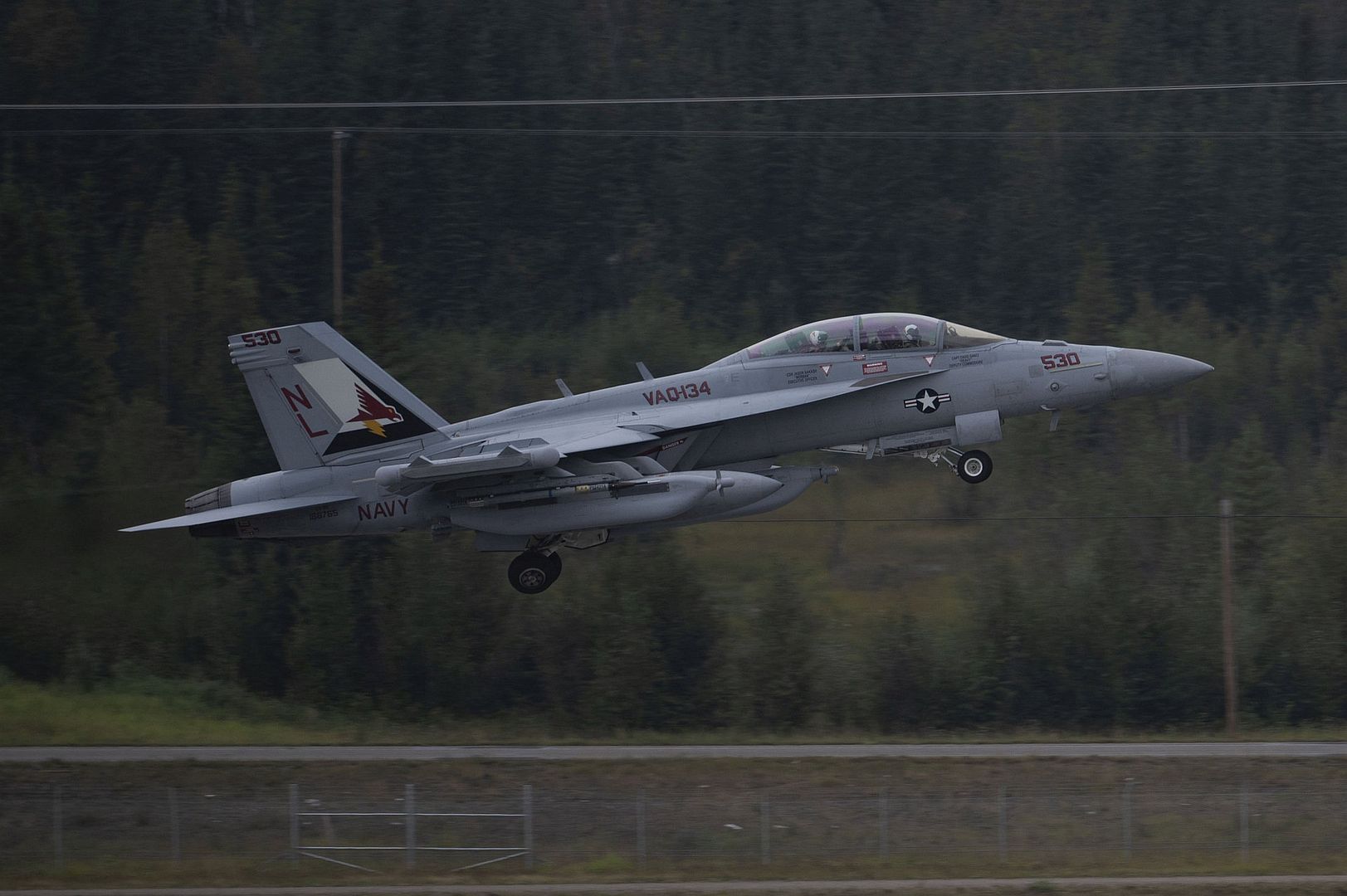
An F-16 Fighting Falcon assigned to the 18th Aggressor Squadron takes off during Red Flag-Alaska 23-3 at Eielson Air Force Base, Alaska, Aug. 22, 2023. The Aggressors provide participants a realistic opposing force by employing enemy tactics during air combat training. (U.S. Air Force photo by Senior Airman Megan Estrada)
An F-35B Lightning II assigned to Marine Fighter Attack Squadron 214 from Marine Corps Air Station Yuma, Arizona, taxis on a runway during Red Flag-Alaska 23-3, at Eielson Air Force Base, Alaska, Aug. 22, 2023. Red Flag provides unique opportunities to integrate various forces into joint coalition and multilateral training from simulated forward operating bases. (U.S. Air Force photo by Senior Airman Megan Estrada)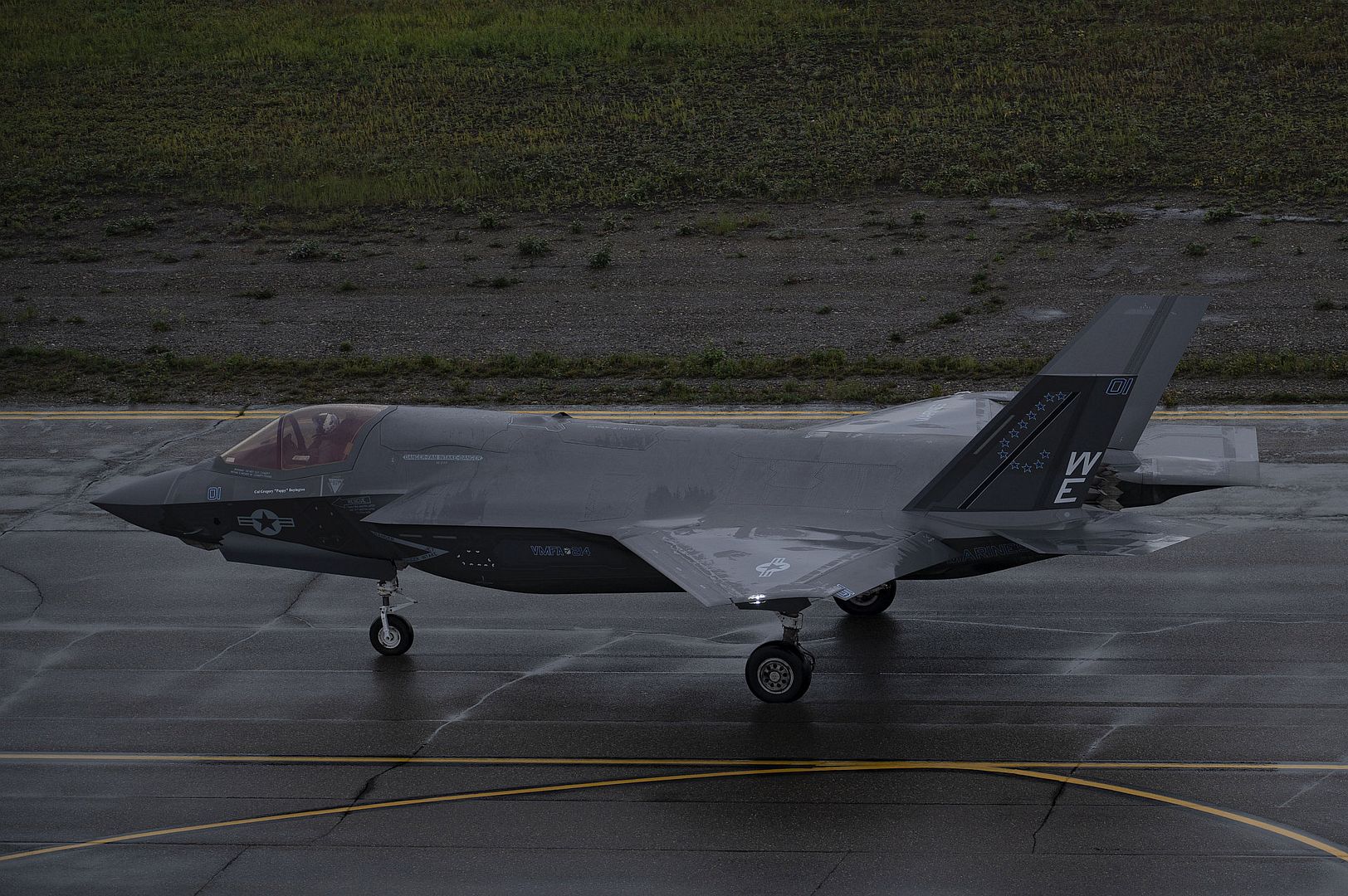
A Royal Australian Air Force F-35A Lightning II takes flight to execute a Red Flag-Alaska 23-3 mission at Eielson Air Force Base, Alaska, Aug. 22, 2023. Red Flag serves as an ideal platform for international engagement and the exercise has a long history of including allies and partners. (U.S. Air Force photo by Senior Airman Megan Estrada)
STRATFORD, Conn., Aug. 24, 2023 – The U.S. Navy awarded Sikorsky, a Lockheed Martin company (NYSE: LMT), a $2.7 billion contract to build and deliver 35 additional CH-53K® helicopters – the largest procurement to date for this multi-mission aircraft.
“This contract award for 35 CH-53K helicopters stabilizes Sikorsky’s nationwide supply base, creates additional production efficiencies, and provides the U.S. Marine Corps with transformative 21st century technologies,” said Paul Lemmo, president of Sikorsky. “Our long-standing partnership led to this best value contract award providing the capability and readiness the Marines need.”
The agreement includes 12 U.S. Marine Corps Lot 7 aircraft, 15 U.S. Marine Corps Lot 8 aircraft, and eight aircraft for Israel._46.jpg?width=1920&height=1080&fit=bounds)
Sikorsky will begin delivering these aircraft in 2026.
This contract significantly advances Sikorsky and the U.S. Navy on the path toward a multi-year agreement and the 200 aircraft Marine Corps Program of Record.
This contract award includes eight additional CH-53K helicopters for the Israeli Air Force and follows the initial production announcement in 2022 for the first four aircraft under a U.S. Navy Foreign Military Sales (FMS) agreement.
The multi-mission CH-53K will support Israeli special operations programs, as well as provide the Israeli Defense Forces with a platform that has the speed, safety, survivability and gross weight capability to support all of its missions, including troop and cargo transport, and search and rescue.
Exercise Thai Boomerang is underway!
Exercise Thai Boomerang is a bilateral fighter jet exercise between the RAAF and the กองทัพอากาศไทย Royal Thai Air Force, focused on enhancing interoperability through a variety of training scenarios.
AusAirForce F/A-18F Super Hornets from No. 1 Squadron will be working alongside Royal Thai Air Force F-16 Fighting Falcon and JAS-39 Gripen fighters.
Exercise Thai Boomerang 23 is held at Korat Royal Thai Air Force Base, Thailand, from 21 August to 1 September 2023.
(Photos courtesy of the RAAF)
-
 Main AdminA Eurocopter EC725 Caracal helicopter assigned to Brazilian Air Base Campo Grande prepares to take off on a search and rescue exercise as part of Exercise Tapio on Brazilian Air Base Campo Grande in Campo Grande, Brazil, August 25, 2023. Exercise Tapio is being conducted as part of the New York National Guard’s State Partnership with Brazil. (U.S. Air National Guard photo by Airman 1st Class Sarah McKernan)
Main AdminA Eurocopter EC725 Caracal helicopter assigned to Brazilian Air Base Campo Grande prepares to take off on a search and rescue exercise as part of Exercise Tapio on Brazilian Air Base Campo Grande in Campo Grande, Brazil, August 25, 2023. Exercise Tapio is being conducted as part of the New York National Guard’s State Partnership with Brazil. (U.S. Air National Guard photo by Airman 1st Class Sarah McKernan)
A U.S. Air Force KC-46A Pegasus arrives at Travis Air Force Base, California, Aug. 25, 2023. This is the second KC-46A that has been delivered to the base. (U.S. Air Force photos by Nicholas Pilch)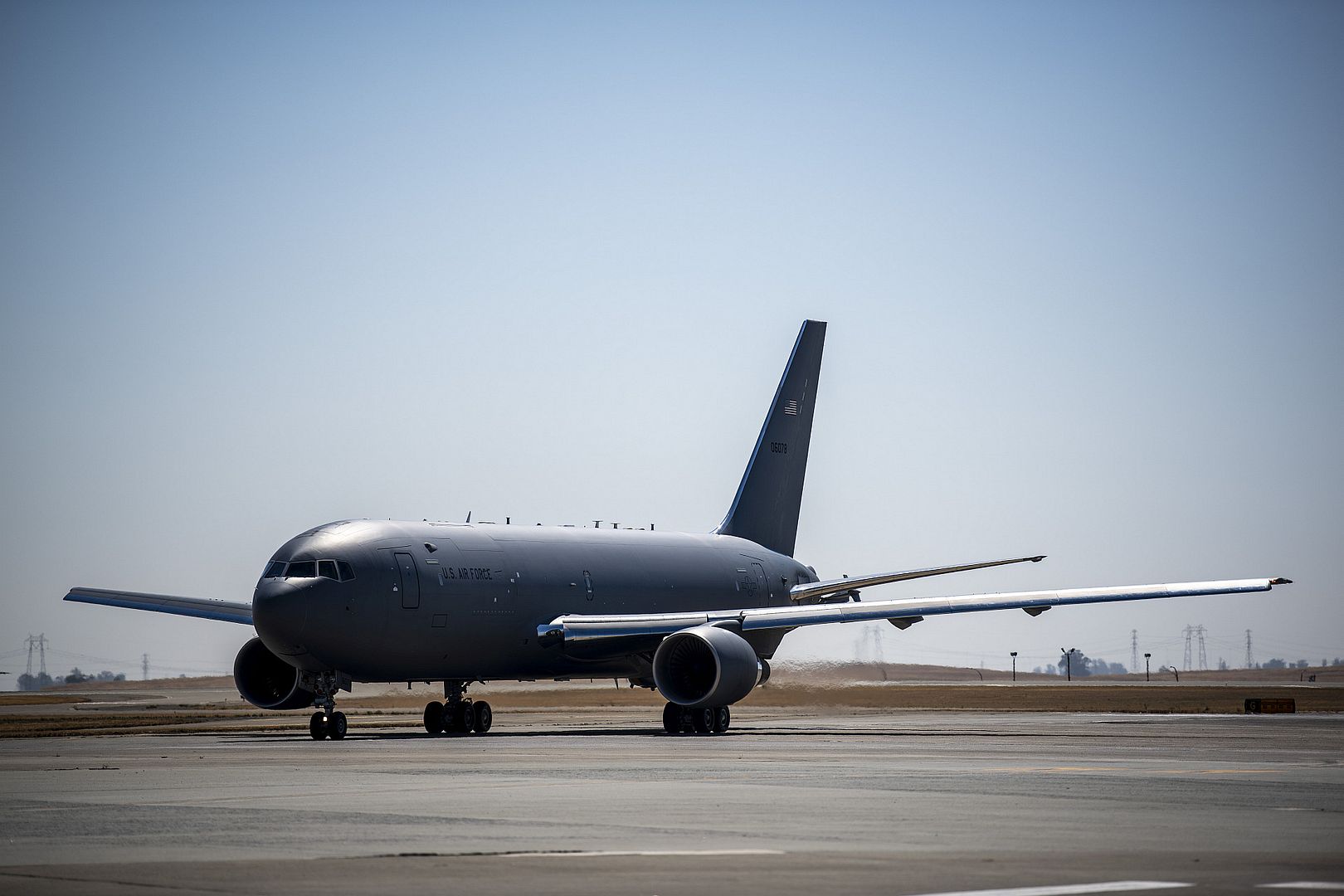

A U.S. Air Force F-16 Fighting falcon assigned to the 480th Fighter Squadron is towed after landing in Kallax Air Base, Lulea, Sweden, in support of Astral Knight 23 Part 6, Aug. 25, 2023. NATO Allies and Partners remain wholly committed to ensuring security and stability throughout the Arctic region, demonstrating the capability to deter adversaries and, if necessary,
defend NATO territory. (U.S. Air Force photo by Airman 1st Class Albert Morel.)
A U.S. Air Force KC-135 assigned to the 351st Air Refueling Squadron, is unloaded at Kallax Air Base, Lulea, Sweden, in support of Astral Knight 23 Part 6, Aug. 25, 2023. Today’s global environment requires the ability to rapidly deploy and sustain operations from great distances. Through collaborative efforts with our Allies and Partners, the U.S. works to provide our forces with the capabilities they need to combat current and future threats. (U.S. Air Force photo by Airman 1st Class Albert Morel.)
PACIFIC OCEAN (Aug. 25, 2023) An F/A-18F Super Hornet from the “Fighting Redcocks” of Strike Fighter Squadron (VFA) 22 makes an arrested landing aboard the aircraft carrier USS Nimitz (CVN 68). Nimitz is underway conducting routine operations. (U.S. Navy photo by Mass Communication Specialist 2nd Class Justin McTaggart)_22_makes_an_arrested_landing_aboard_the_aircraft_carrier_USS_Nimitz_9tDQgzTJgsUj6dM3YG2sEN.jpg?width=1920&height=1080&fit=bounds)
PACIFIC OCEAN (Aug. 25, 2023) An E/A-18G Growler from the “Cougars” of Electronic Attack Squadron (VAQ) 139 makes an arrested landing aboard the aircraft carrier USS Nimitz (CVN 68). Nimitz is underway conducting routine operations. (U.S. Navy photo by Mass Communication Specialist 2nd Class Justin McTaggart)_139_makes_an_arrested_landing_aboard_the_aircraft_carrier_USS_Nimitz_uMMWnznm8UQ9wQgJgoRb9Z.jpg?width=1920&height=1080&fit=bounds)
PACIFIC OCEAN (Aug. 26, 2023) An F/A-18E Super Hornet from the “Kestrels” of Strike Fighter Squadron (VFA) 137 flies above the aircraft carrier USS Nimitz (CVN 68). Nimitz is underway conducting routine operations. (U.S. Navy photo by Mass Communication Specialist 2nd Class Justin McTaggart)_137_flies_above_the_aircraft_carrier_USS_Nimitz.jpg?width=1920&height=1080&fit=bounds)
PACIFIC OCEAN (Aug. 26, 2023) An F/A-18E Super Hornet from the “Kestrels” of Strike Fighter Squadron (VFA) 137 approaches for an arrested landing aboard the aircraft carrier USS Nimitz (CVN 68). Nimitz is underway conducting routine operations. (U.S. Navy photo by Mass Communication Specialist 2nd Class Justin McTaggart)_137_approaches_for_an_arrested_landing_aboard_the_aircraft_carrier_USS_Nimitz_1HFLXm8u27LrR9UPh8xkpn.jpg?width=1920&height=1080&fit=bounds)
PACIFIC OCEAN (Aug. 26, 2023) An F/A-18F Super Hornet from the “Fighting Redcocks” of Strike Fighter Squadron (VFA) 22 makes an arrested landing aboard the aircraft carrier USS Nimitz (CVN 68). Nimitz is underway conducting routine operations. (U.S. Navy photo by Mass Communication Specialist 2nd Class Justin McTaggart)_22_makes_an_arrested_landing_aboard_the_aircraft_carrier_USS_Nimitz-1_fKpZQMrAPae7GuUxfmzPp5.jpg?width=1920&height=1080&fit=bounds)
A U.S. Air Force RC-135 Rivet Joint assigned to the 763rd Expeditionary Reconnaissance Squadron departs after receiving fuel from a KC-135 Stratotanker assigned to the 912th Expeditionary Air Refueling Squadron during Operation Agile Spartan above the U.S. Central Command’s area of responsibility, Aug. 19, 2023. Agile Spartan demonstrated flexible response options through decisive combat airpower in air superiority, airlift, surveillance and reconnaissance. The month-long, multinational operation demonstrated interoperability between regional partners, improved response capabilities, and further enhanced security throughout the region. (U.S. Air Force photo by Senior Airman Leon Redfern)
A U.S. Air Force RC-135 Rivet Joint assigned to the 763rd Expeditionary Reconnaissance Squadron taxis off the runway during Operation Agile Spartan at Naval Support Activity Souda Bay, Greece, Aug. 19, 2023. The RC-135 Rivet Joint reconnaissance aircraft participated in this exercise to demonstrate its support to theater and national level consumers with near real-time, on-scene intelligence collection, analysis and dissemination capabilities. The month-long, multinational operation demonstrated interoperability between regional partners, improved response capabilities, and further enhanced security throughout the region. (U.S. Air Force photo by Senior Airman Leon Redfern)
AURORA, Colo. – Aug. 28, 2023 – Northrop Grumman Corporation (NYSE: NOC) successfully demonstrated its Deep-Sensing and Targeting (DSaT) platform at the Experimental Demonstration Gateway Event (EDGE) ’23, hosted by the U.S. Army.
During a simulated, real-world tactical scenario, the company successfully:
Gathered and fused multi-domain data for rapid dissemination to the Tactical Operations Center;
Collected and analyzed data from commercial satellites onboard the aircraft;
Met 100-percent of the criteria for the experimentation
Pablo Pezzimenti, vice president, integrated national systems, Northrop Grumman: “Northrop Grumman’s groundbreaking technology can help the Army realize its vision of deep-sensing with the ability to identify, monitor, target and strike threats from farther distances and with greater precision. We are supporting the warfighter’s targeting needs with intelligence collection beyond line of site and leveraging aerial assets in providing multi-domain fused data directly to the front lines.”
DSaT is a multi-domain deep-sensing architecture integrated into a civilian aircraft, providing intelligence collection that reaches beyond the visual line of sight of local sensors. While leveraging elements of the TITAN pre-prototype system, its capability fills a gap in data collection by combining space-based geospatial intelligence (GEOINT) imagery with aerial and terrestrial intelligence from commercial and military space systems.
Phase 1 successfully demonstrated the GEOINT capabilities with future phases planned incorporating multiple intelligence platforms.
Northrop Grumman is a leading global aerospace and defense technology company. Our pioneering solutions equip our customers with the capabilities they need to connect and protect the world, and push the boundaries of human exploration across the universe. Driven by a shared purpose to solve our customers’ toughest problems, our 98,000 employees define possible every day.
The CRJ-700 jet was used at EDGE ‘23 in Yuma, Arizona to demonstrate DSaT’s multi-domain deep sensing architecture. The DSaT capabilities are integrated into a civilian aircraft, providing intelligence collection that can reach beyond the visual line of sight of local sensors. (Photo Credit: Northrop Grumman)
Post a reply
- Go to Next topic
- Go to Welcome
- Go to Introduce Yourself
- Go to General Discussion
- Go to Screenshots, Images and Videos
- Go to Off topic
- Go to Works in Progress
- Go to Skinning Tips / Tutorials
- Go to Skin Requests
- Go to IJAAF Library
- Go to Luftwaffe Library
- Go to RAF Library
- Go to USAAF / USN Library
- Go to Misc Library
- Go to The Ops Room
- Go to Made in Germany
- Go to Campaigns and Missions
- Go to Works in Progress
- Go to Juri's Air-Raid Shelter
- Go to Campaigns and Missions
- Go to Works in Progress
- Go to Skinpacks
- Go to External Projects Discussion
- Go to Books & Resources
